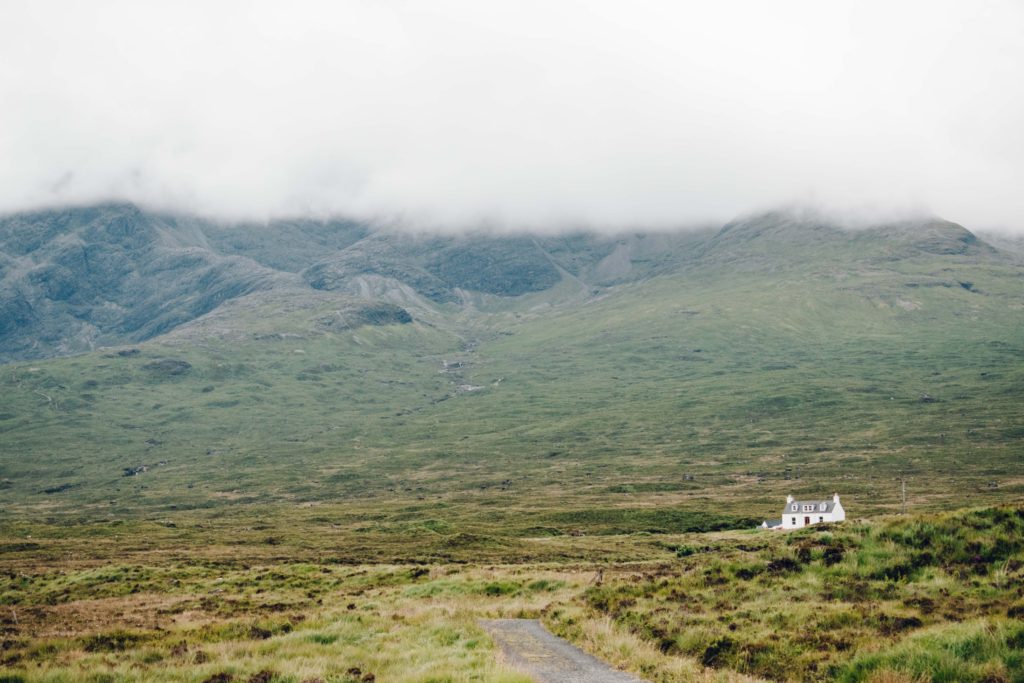
After Edinburgh, Skye is probably the most famous destination in Scotland. Breathtaking highland scenery, truly fantastic hiking, some of UK’s most iconic scrambling and climbing routes, beautiful places to stay and plates of fresh seafood. It is easy to appreciate the island saying, “Skye is conclusive proof that, sometimes, God was just showing off.”
Known as the Misty Isle in Gaelic (Eilean a’ Cheo), Skye is the largest and most northerly of the Inner Hebridean islands. It stretches for almost 50 miles (80km), and yet its coastline so rugged and covered in inlets that no part of the island is more than 5 miles (8km) from the sea.
It is also surprisingly accessible. Skye is the nearest island to the mainland, and since 1995 a bridge has connected it to the mainland. Several of the most impressive landscapes are only a short walk from the road. It is therefore a great destination for both the hardcore adventurer, and those just looking to dip their toes into the wilder side of Scotland, without forgoing the creature comforts.
Don’t Miss
Hiking! – there is just so much to hike, walk, scramble and climb on Skye – the Cuillins alone are home to 12 munros.
Find your own wild swimming pool – avoid the crowds at the Fairy Pools and help keep Skye pristine by searching out your own private swimming spots. Ask around locally for residents’ favourite hidden gems.
The Cuillin Ridge – admire it from a cosy bar over a whisky, hike around it and alongside it, cross all your fingers that it peeks out of the clouds just long enough to glimpse its jagged peaks… or maybe even attempt to traverse it!
The Whisky – Talisker is the most famous, but I recommend visiting Torabhaig or Raasay for a more lowkey experience. If a tour isn’t for you, settle in after a long walk to savour a malt or two at the historic Stein Inn or Seamus’ Bar.
Need To Know
Currency – Pounds Sterling (£)
Language – Gaelic and English.
Closest Airport – Inverness (INV)
Getting around – cycle, hike, drive or tour!
Banks/ATMs Most places accept Mastercard and Visa but worth carrying some cash for the small community stalls and cafes. ATMs are available in Portree, but less widespread across the rest of the island.
Staying in Touch – signal is patchy outside of the main towns, so do not rely on it whilst out on the hills. Most cafes offer free WiFi.
Weather – Changeable – all of the photos below were taking over one week in the middle of the summer! April and May are the driest months; October is the wettest.
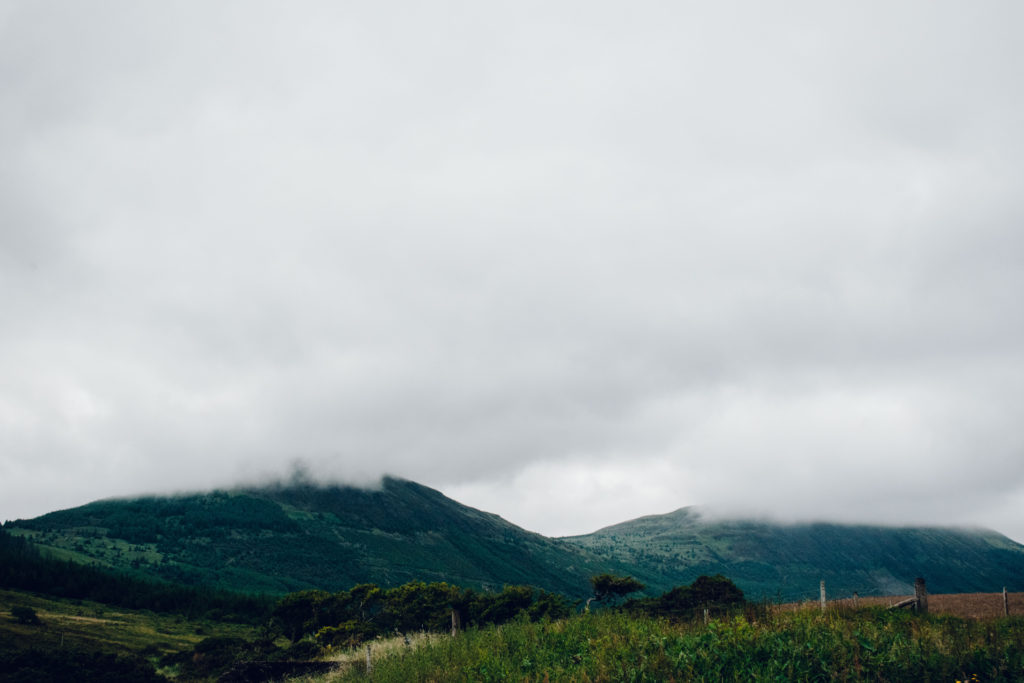
WHEN TO GO
Do not expect to be alone in seeking out Skye’s charms! The accessibility and popularity of Skye means that tourism has grown at staggering rates in recent years. More than 650,000 now make the trip each year – with the Fairy Pools alone getting more than 200,000 visitors. The island can get incredibly busy with overflowing carparks, hotels sold out months in advance and restaurants fully booked for weeks. Therefore, you might want to consider travelling outside of peak season – essentially the summer months, but in particular the school holidays of July and August. Whilst it might be cold, in the winter months you are likely to have the best sights all to yourself, although some manmade attractions may be shut. As an additional perk, the notoriously expensive accommodation on the island will also be cheaper and you are more likely to avoid the dreaded midges!
PROTECTING SKYE
The number of visitors to Skye in the busiest months is inevitably having an impact on the environment. The sheer volume of traffic, both foot and vehicle, is causing significant erosion – particularly at the Fairy Pools, The Old Man of Storr and the Quiraing.
Before travelling, you may therefore want to consider how best to minimise the impact of your visit, and how you can ensure your holiday spending supports local communities. Hopefully this guide will help you do the second, and on the first, the best place to start – no matter where you are visiting – are the Leave No Trace Principles.
There are a variety of ways you can explore a company’s environmental credentials. Many will now publish their environmental policies on their websites, whilst The Green Tourism Award is an official stamp of approval that marks out a business for its environmentally-friendly credentials, such as waste management, efficiency and biodiversity.
This guide includes some of the most popular destinations (denoted by a little * to help guide your planning), but when you get there if they look really busy, you might wish to consider visiting an alternative spot instead so as not to add to the volume of visitors. The best thing about Skye is that it is all so spectacular you won’t be missing out and are likely to find your own, special slice of the Misty Isle. If you are visiting a popular sight, stick to the paths to avoid further erosion to the surrounding countryside.
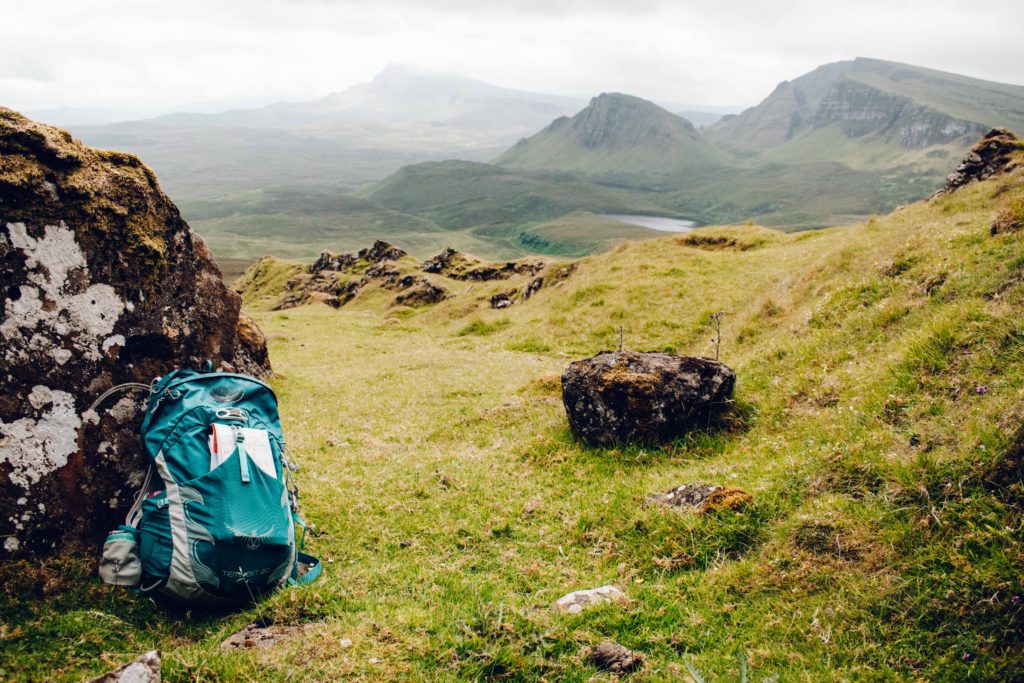
GETTING THERE
The closet domestic airport to Skye is Inverness – around a two and half hour drive away. The international airports of Glasgow and Edinburgh are about four and a half/five hours away.
From the mainland you have two main choices. CalMac operates a ferry from Mallaig to Armadale every four hours. Tickets cost £2-£4 and the journey takes 35 minutes. It is strongly recommended to book in advance online, as places fill up fast. There is also a bridge which connects Kyle of Lochalsh via the rather spectacular A87, to the southeast of Skye.
The small, privately run, Glenelg Ferry operates between Glenelg and Kylerhea between Easter and October. The ferry is the Glenachulish, the last manually operated turntable ferry in Scotland. A car with up to four passengers costs £15.
Bus services are available from Kyle of Lochalsh to Skye, and City Link runs coaches from both Glasgow and Inverness.
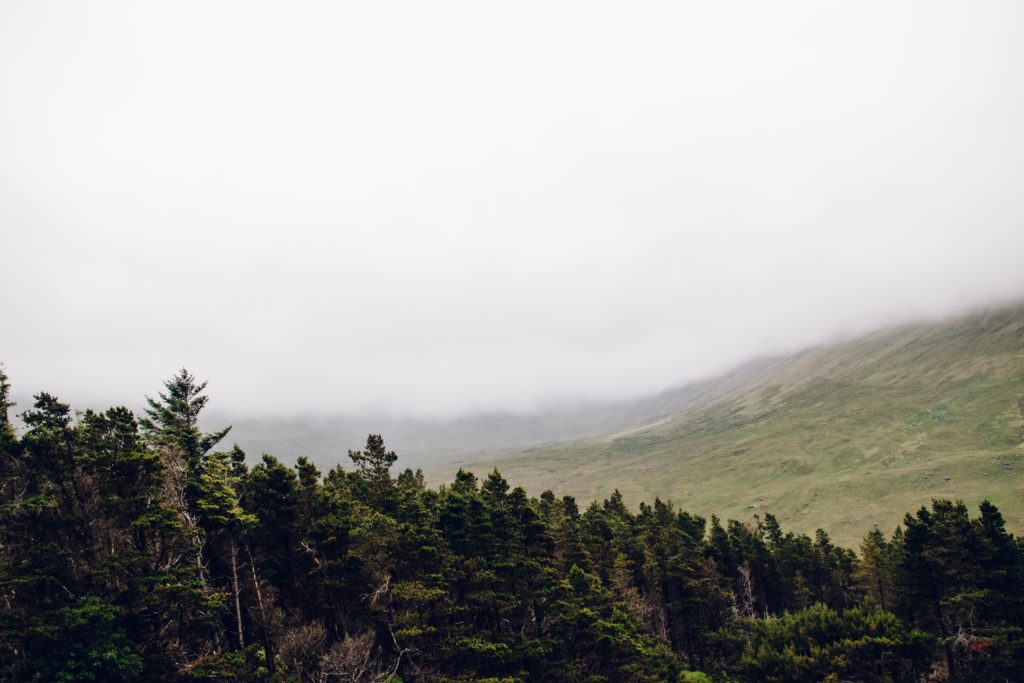
The Midge
The dreaded midge (pronounced “mi-gee”). Known variously as the “scourge of the Scottish summer”, the Caledonian Luftwaffe, the hungry rain and many other things filled which such expletives I’m not sure WordPress would even allow me to press publish.
To clear up some confusion right off, midges are not mosquitoes. They are a much smaller version of biting terrorist. The Scottish midge is a tiny flying insect with a wing-span of 2-3 mm. There are actually over 35 species of biting midge in Scotland but it’s the Highland varient that causes the most problems. Midge season tends to be late May until September. Their wings flap 1000 times a second, meaning they have the highest wing speed of any animal in the world. And if you are feeling sceptical at how ferocious they are… just know that a swarm can deliver 3000 bites in an hour. And in my experience, they will happily dish out all those bite to a single person in far less than an hour…
There is no getting around it. They’re miserable! The only thing more infuriating than the little monsters themselves, are those people who will tell you – with an air of smug know-it-all – that of course it’s only the female midges that bite. Well, I can assure you no one has ever felt comforted by that utterly useless fact when their head is engulfed in a cloud of Scottish biting beasties as they try to run blindly back to their car, only to discover there are hundreds of their hungry cousins waiting in the car too.
Distressingly, midges are attracted by the carbon dioxide in your breath, so short of stopping breathing what can you do to survive their onslaught? Thankfully, plenty!
Seek out the Scottish weather! – Midges love thick woodland and to be near water. They thrive in dark and damp conditions. So you want to find some wind! Even a gentle breeze will help, and avoid camping directly next to water (other than where you might get a sea breeze).
Repellent – the best two options are Smidge and rather bizarrely, Avon Skin So Soft! The advantage of Smidge is that it also works against ticks, but you will of course miss out on the baby’s-bottom-smoothness that comes from Skin So Soft… Burning a bundle of sage leaves at your camp is also surprisingly effective, but probably not something you have immediately to hand in your rucksack.
Head net – yes they look ridiculous. But you will be so thankful you have it come midge o’clock. Smidge make the best. Some choose to wear a hat with a brim underneath if you want to feel a bit less claustrophobic. Note that a mosquito net will not do! The mesh is simply too big.
The right clothes – choose lighter coloured clothes. Midges like dark clothing. Long sleeves and long trousers at dawn and dusk are a must.
Post bite… carry antihistamines so that if you do get bitten you can reduce the itching. Midge bites aren’t dangerous, and carry no diseases. They are simply unpleasant and annoyingly itchy.
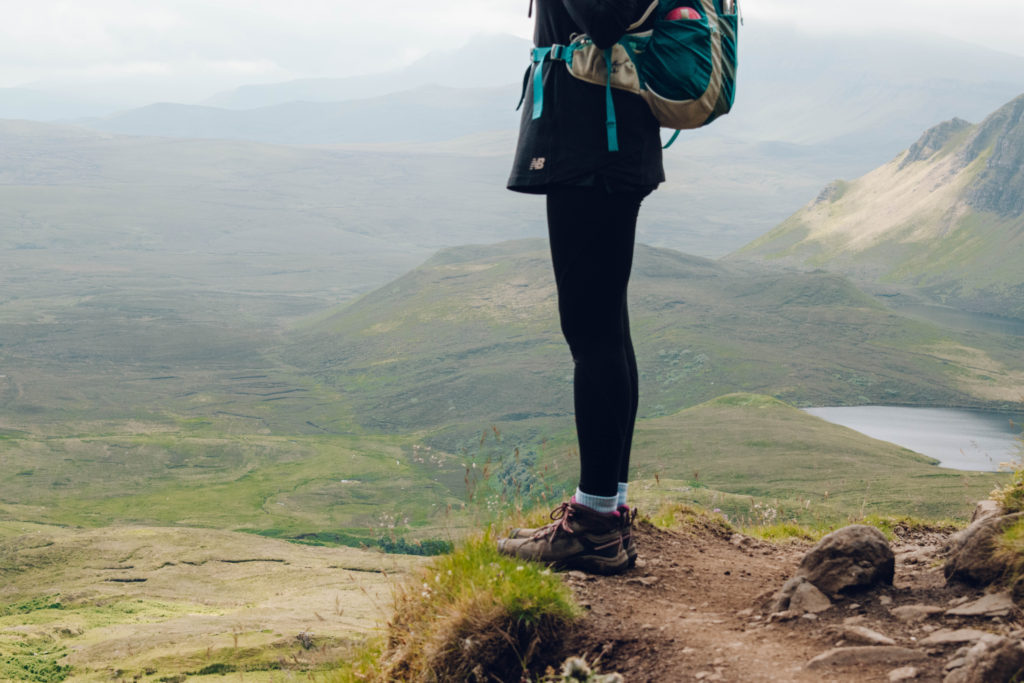
GETTING AROUND
Having your own form of transport is going to get you to the remotest corners, and will allow you to make the most of the island. Car rental is relatively cheap in the UK, so you are likely to find a good deal online. A more compact vehicle is best on Skye given the squeezy roads!
Many of the roads on Skye are not wide enough to allow two vehicles to pass side by side, so brush up on your “single lane etiquette” before arriving. Passing places (marked by black and white poles) are frequent, so if you meet another can one of you might need to reverse a short distance to allow the other to pass. A quick friendly wave of the hand to thank the other driver – and then to acknowledge the thank you in return if you were the one to pull over – will endear you quickly to your fellow drivers and have you embracing the British sense of politeness in no time. If you want to go more slowly and admire the scenery, use the passing places to pull in briefly to allow cars behind you to overtake. Give sheep, cyclists and weary hikers plenty of space, and pass them wide and slow. Never, ever park in passing places!
Local buses on the island are operated by Stagecoach, but are principally focused on serving the local community, connecting the main towns and villages.
If you decide to go on an organised tour, locally Eilean o’Cheo are particularly highly recommended, and nationally, Wilderness Scotland and Rabbie’s have good reputations and robust environmental policies. If you are looking for something slightly slower paced, check out the wonderful Sky Ghille – Mitch Patridge – who runs wonderful wild fishing, foraging and wildlife watching walks.
WHAT TO SEE
Neist Point Lighthouse * – surely one of the most photographed lighthouses in the world, Neist Point provide panoramic views out over the sea and the dramatic coastline. The 1.5 miles/2.5km return walk is straightforward, and on a concrete path, but is steep in places. Although around an hour to get there and back, allowing time for a few stops to catch your breath on the way back and plenty of photo opportunities. It can get very windy out on the cliffs so take warm layers, and do not stray too close to the edge. The carpark is fills up quickly, but there are additional spaces to park further back along the road.
Claigan Coral Beach – Skye is not really known for its beaches in the way that its Outer Hebridean neighbours are, but white, sandy Coral Beach is the exception! The 3.6km walk to the beach and back is easy, along a farm track. There is also a lovely walk across the beach and surrounding farmland to Dunvegan Castle. There is a small gravel carpark at the start of the track. Note that camping is prohibited.
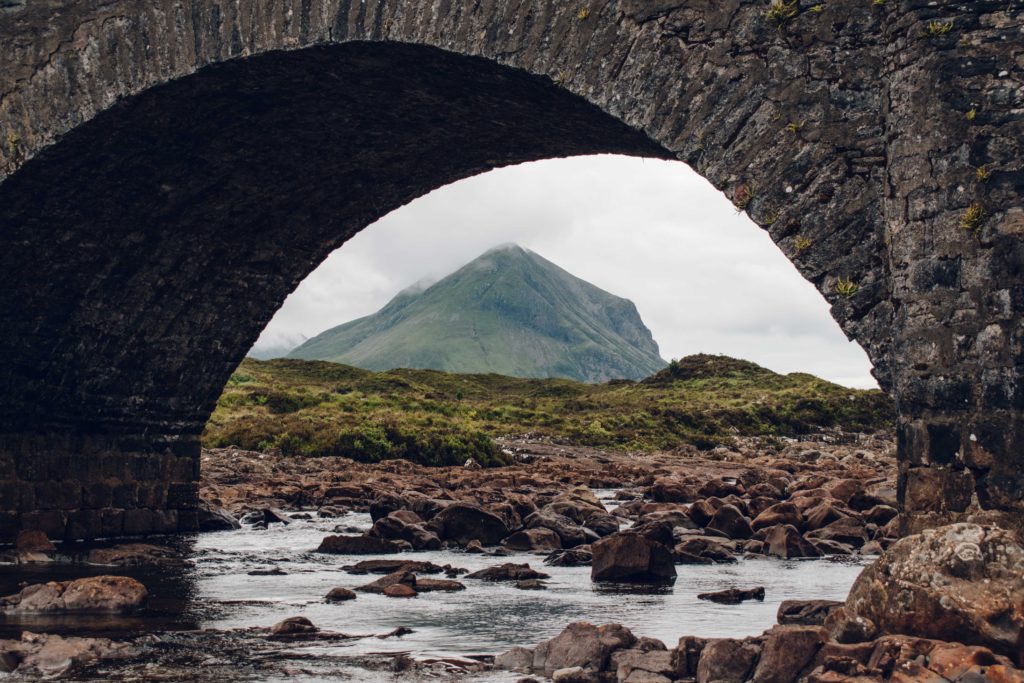
The Old Bridge of Sligachan – absurdly picturesque, arched stone bridge, perfectly framed by the Black Cuillins. The main draw however, is the water beneath the bridge. It has the power to grant you eternal beauty…
The tale goes that news of the feats of Scotland’s greatest warrior woman, Scáthach, reached Ireland’s greatest warrior, Cú Chulainn, who was very competitive. He travelled over to Skye and challenged her to a fight, which raged for weeks, rattling mountains and causing animals to flee the island. However, Scáthach young daughter was terribly upset by the fighting and ran crying to the river, begging someone to make it stop. Thankfully the river fairies heard her plea, and told her to head home to make a broth so delicious, that the fighters would be unable to resist it. She did exactly that and so the battle finally ended! However, the portal to the fairy world remained open, meaning anyone who dunks their head since will attain eternal beauty!
The Fairy Pools * – as the pools are such a famous Skye/wild swimming destination, I couldn’t help but be very disappointed when we arrived on our last visit. It was absolutely teaming with people – on a grey, drizzly day, weeks before the school summer holidays began. More than anything, this really brought home the environmental impact Skye’s tourism boom is having. I’m a passionate believer in making the outdoors more accessible, and I think the more we encourage people to get outside the better for everyone’s wellbeing and for fostering a desire to protect our natural spaces. But I certainly didn’t want to strip down to my swimsuit as a group of thirty people peered over the edge snapping pictures whilst I did so! As for working out how I could get it off and back into my warm clothes after my swim… well, even The Husband with his Mr Tickle-esque arms isn’t that dexterous!
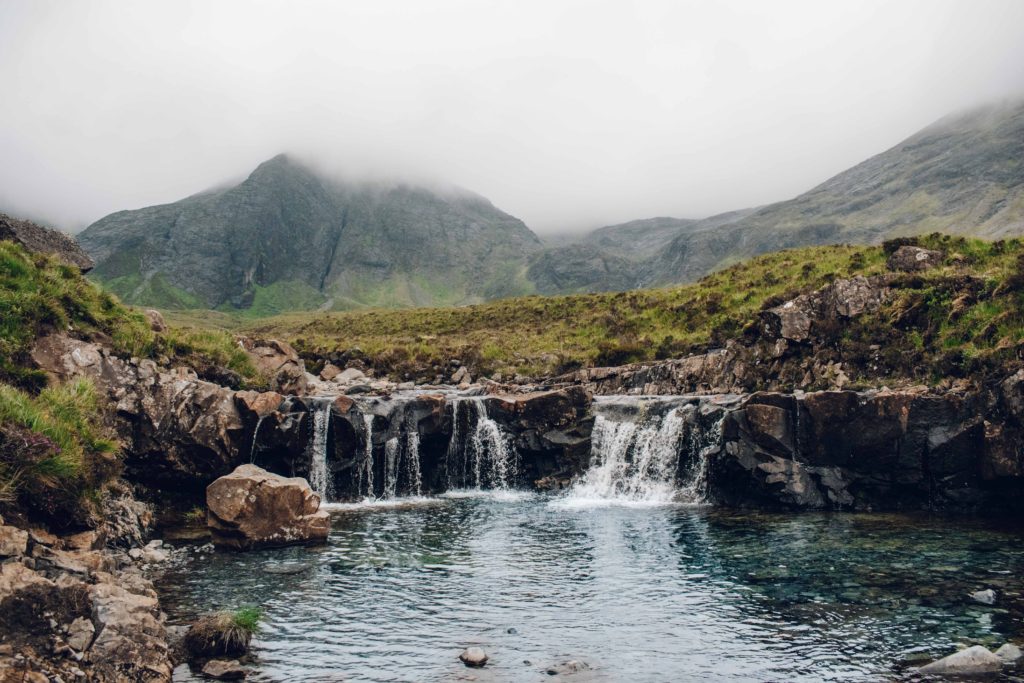
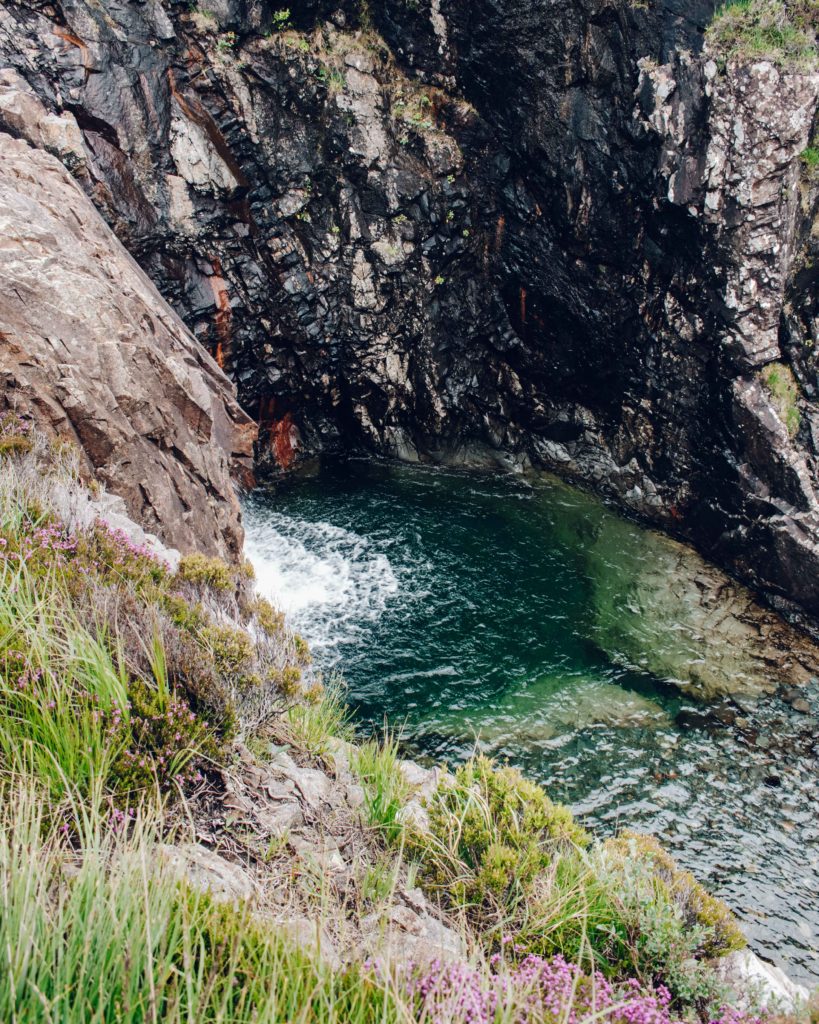
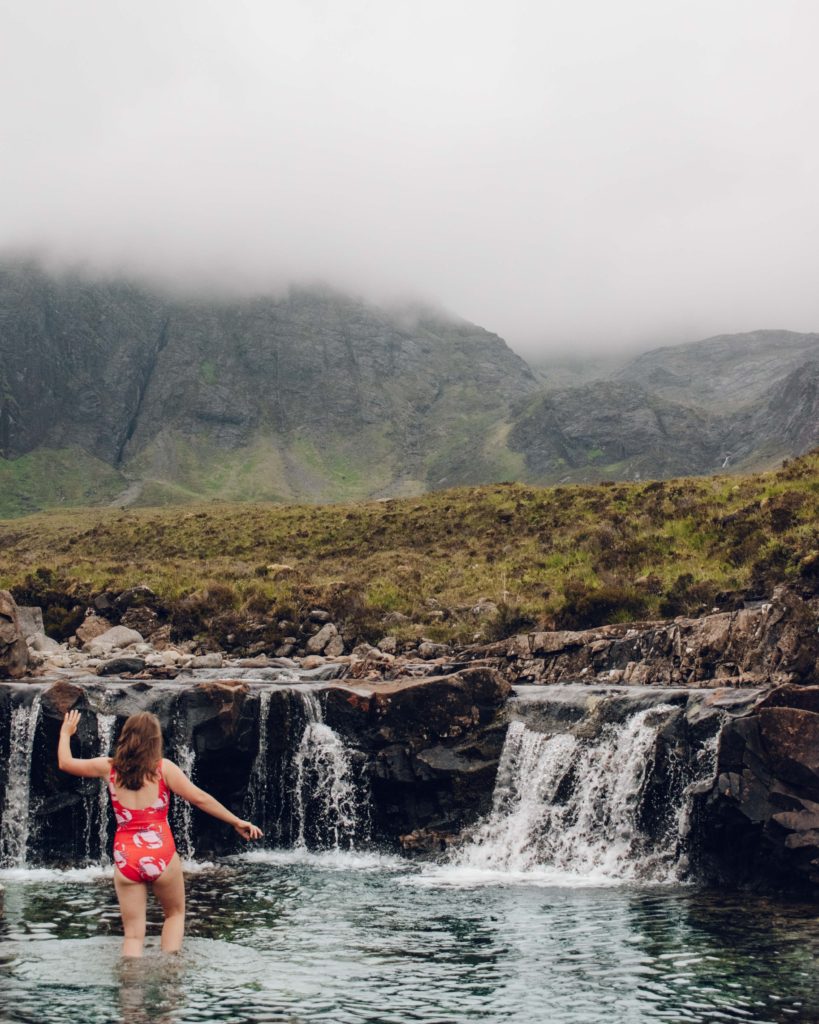
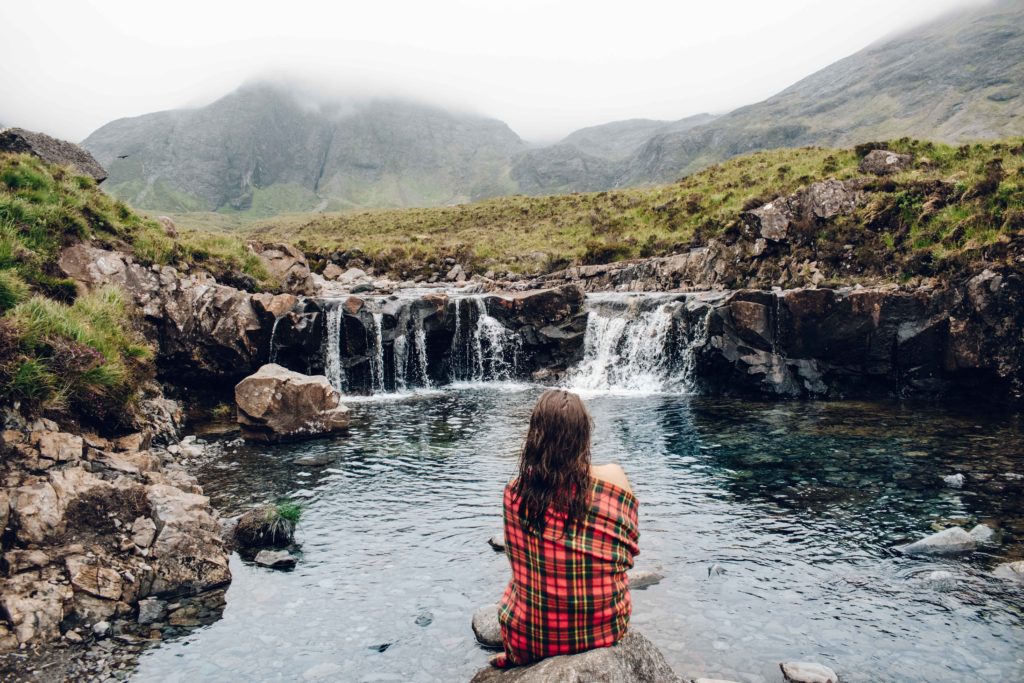
However, fear not, you can still find some solitude. If you come after 5pm and walk 2/2.5km up the valley you are almost certain to find a quiet spot to yourself. Despite my initial shock at the crowds swimming here was still wonderful, and the water amazingly clear so it is worth bringing goggles. If you want to swim at the famous underwater arch, it is at about the 1/1.5km mark.
There is a big car park run by the charitable the Outdoor Access Trust for Scotland (paid: £5 for cars; £15 for minibuses; £8 for motorhomes) and toilets (9am-5pm). The short walk to the pools takes around ten minutes, and whilst the last section back to the car park is uphill, the rest is relatively flat.
Wild Swimming – there are some wonderful places to get your cold water fix on Skye. My top favourites include the loch and waterfalls on Coire Lagan (bring extra warm gear, the water here is always perishingly cold!) and the purple-hued plunge pool at the left end of Talisker Bay accessible at low tide.
The Fairy Pools (covered above) are far from Skye’s only turquoise blue, crystal clear plunge pools. Given the steepness of the hills and the amount of water on the aptly named Misty Isle, find yourself any reasonably sized river and you are likely to find a series of pools and waterfalls as you follow the river up the mountain. And at most of these, you are likely to have them entirely to yourself. We had a wonderful day at a “secret” spot in the south west of the island recommended by a local café owner. So put your most friendly face on and ask around for recommendations.
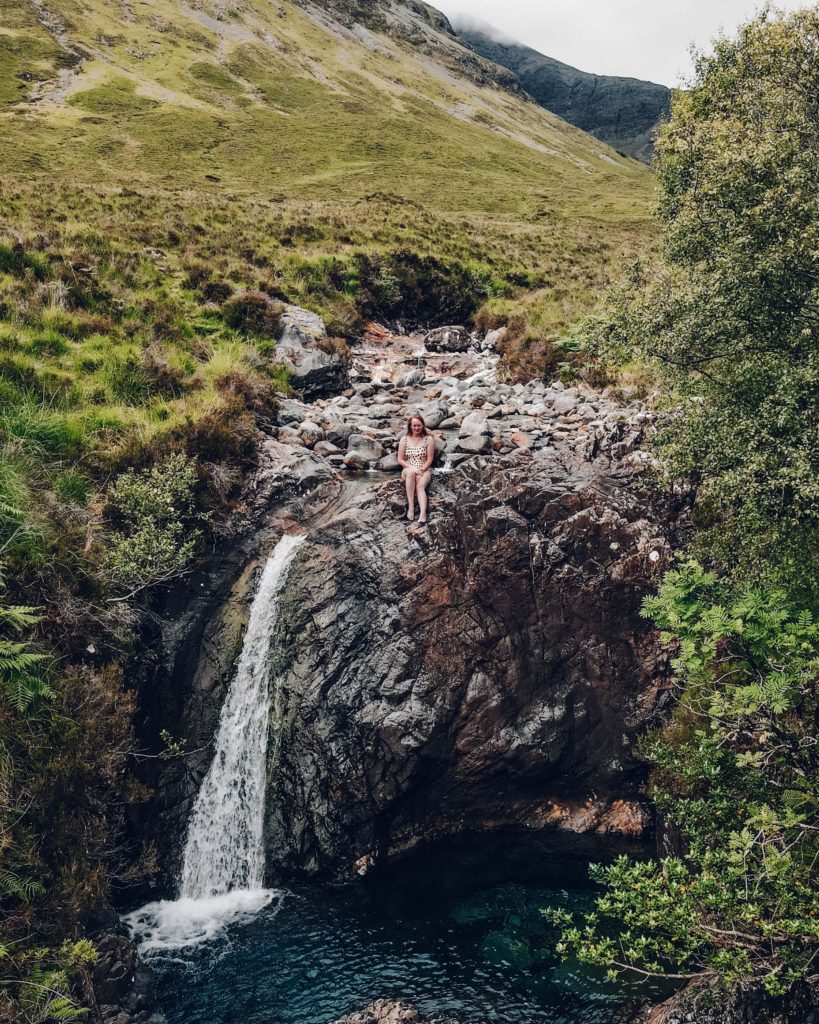
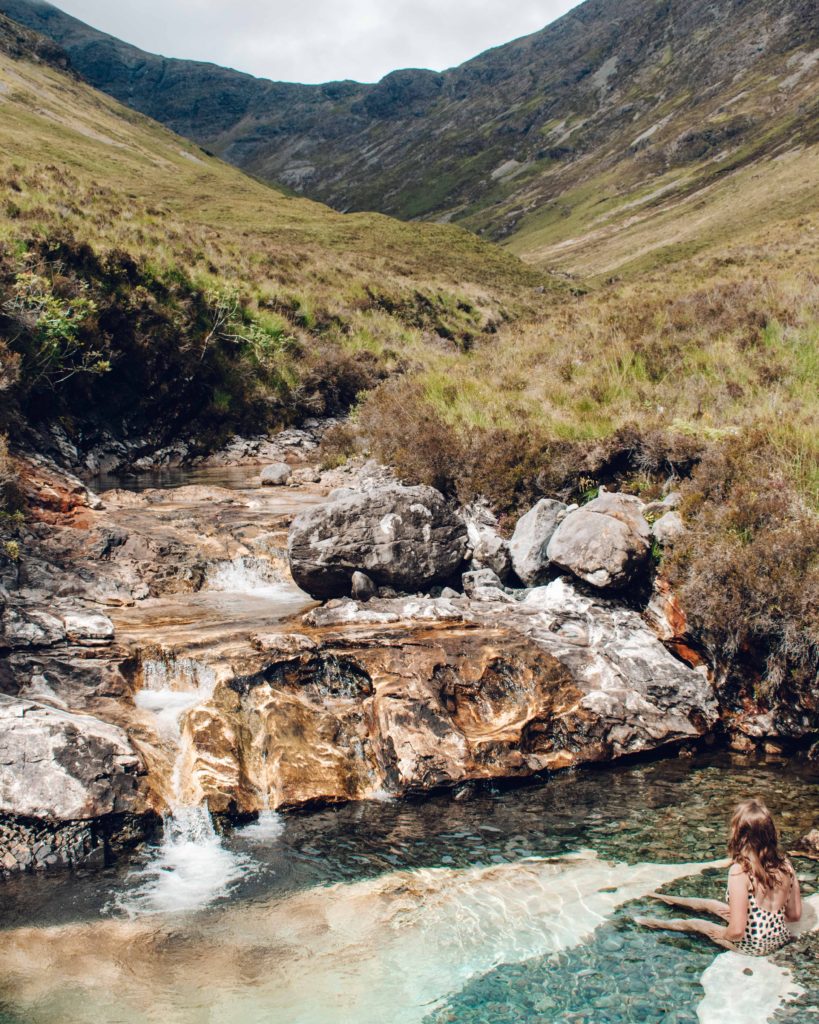
Kilt Rock and Mealt Falls * – great view over the edge of the north eastern cliffs above an impressive 90 metre waterfall tumbling into the sea below. Unsurprisingly it is even more impressive immediately after rain! Expect to share the view with bus loads of fellow sightseers given its accessibility – the view of the falls is only a few metres from the carpark. Parking is free.
Talisker Bay – come at low tide to enjoy the wonderful stretch of black sand beach, and even better, the purple rock pools at the left end for a bracing swim! On the right hand side of the bay is a large waterfall, which on a windy day blows back on itself. On a sunny summer’s evening it is an unbeatable spot. It is a short, flat walk of around 1.5 miles from the small parking area to the beach. Don’t be surprised if you find a few peacocks roaming around on your arrival – just to the right by the parking area are a large number of bird pens, filled with some really exotic, and definitely not native, feathery friends! Note that camping, and overnight parking, is prohibited.
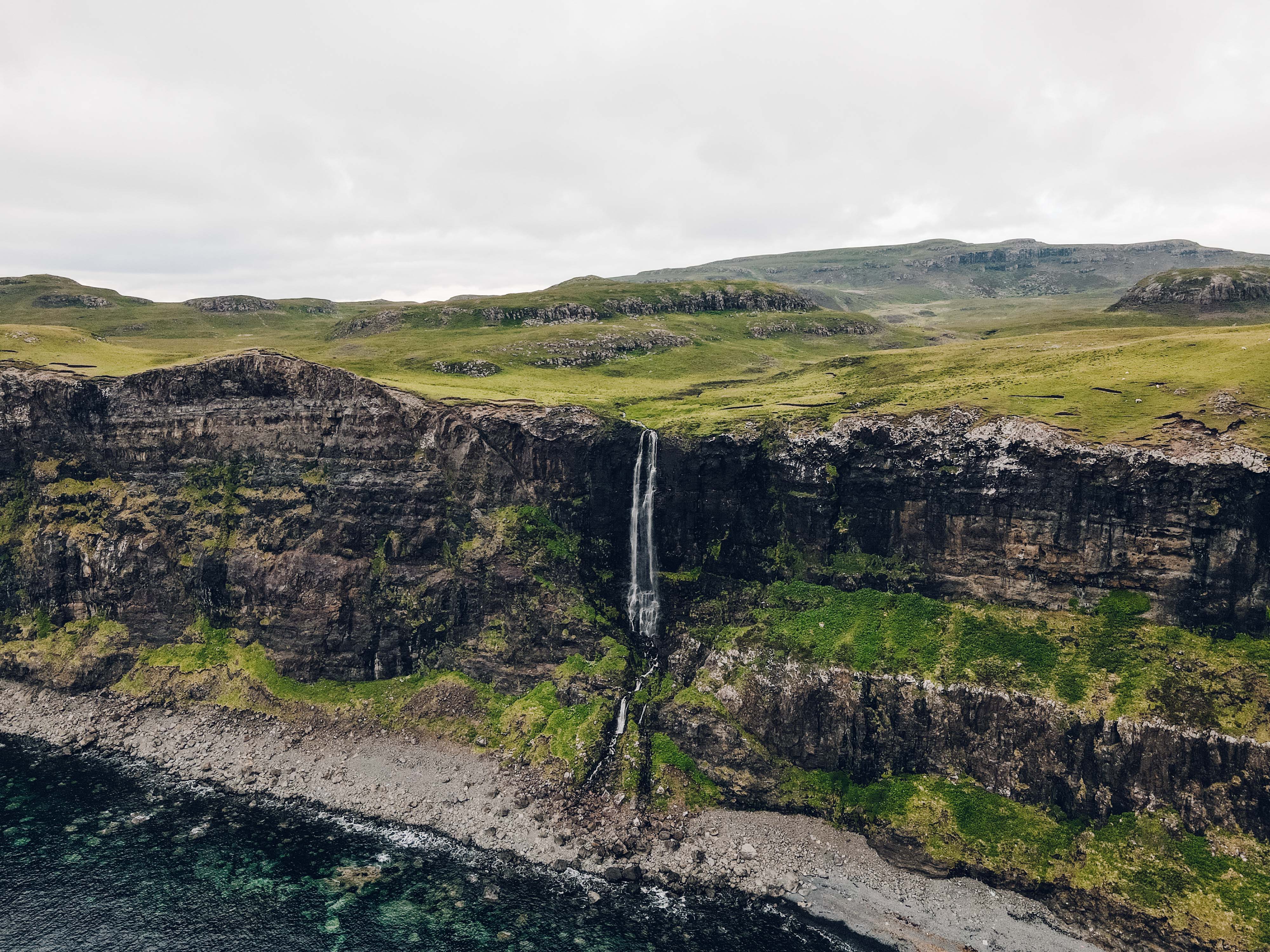
HIKING
There is just so much to hike, walk, scramble and climb on Skye that it really needs multiple guides – the Cuillins alone are home to 12 munros. But others have covered that far more comprehensively than me – check out the utterly fantastic Walk Highlands for the best walk reports covering all of Scotland, or the Cicerone guide to Walking the Isle of Skye for more inspiration. The below is the top picks for my favourite Skye walks.
Outside of the main towns, mobile reception is very patchy so don’t rely on it whilst out on the hills. We are so lucky in the UK to have the truly fantastic Ordinance Survey maps – OS Explorer Maps 23 and 32 cover Skye. You can buy them online from Ordinance Survey, or in many shops in Portree. We always take a paper map as a backup but in recent years have become total converts to the OS App (be sure to charge your phone and download the section of map you need before you leave!).
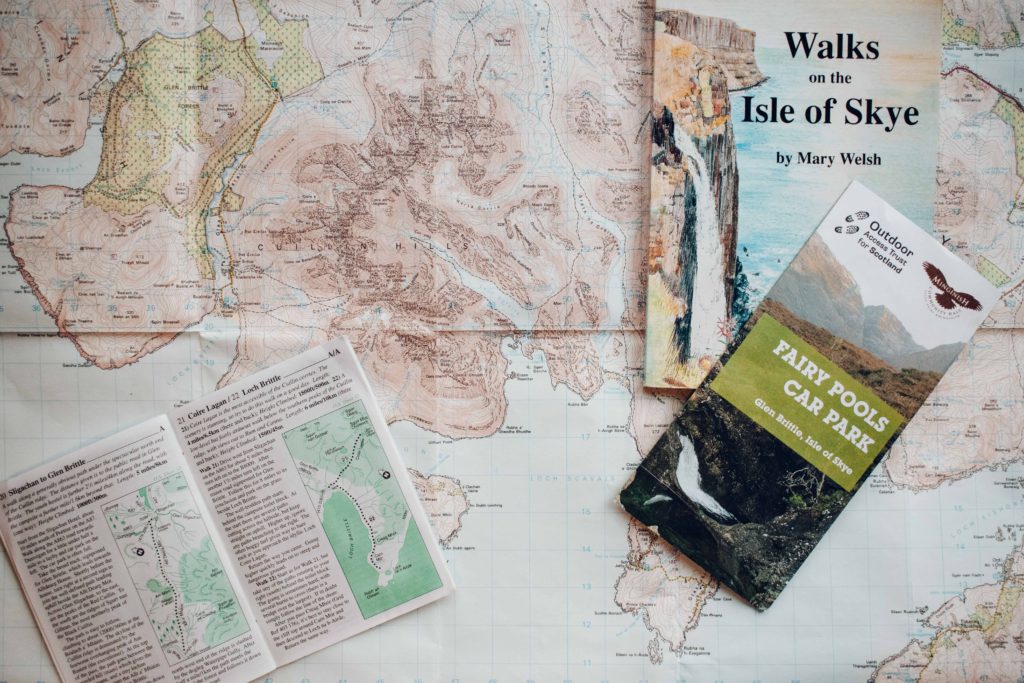
QUIRAING *
Distance: 4 miles/6.5km
Ascent: 374m
Difficulty: Medium
Parking: Three hours for £3, or £5 for six.
A Skye icon and truly spectacular. Walking routes can be adapted depending on how far you want to go, and how much ascent you wish to tackle. The most popular is a loop past some of the most famous landmarks such as the Needle and the Prison, before climbing up on to the escarpment to look down on the Quiraing from above. The route is easy to follow as the path is well defined and well worn. At the point you climb up to the stile to start the climb up the escarpment, you can add an additional section on by turning right to enjoy Sròn Vourlin before doubling back.
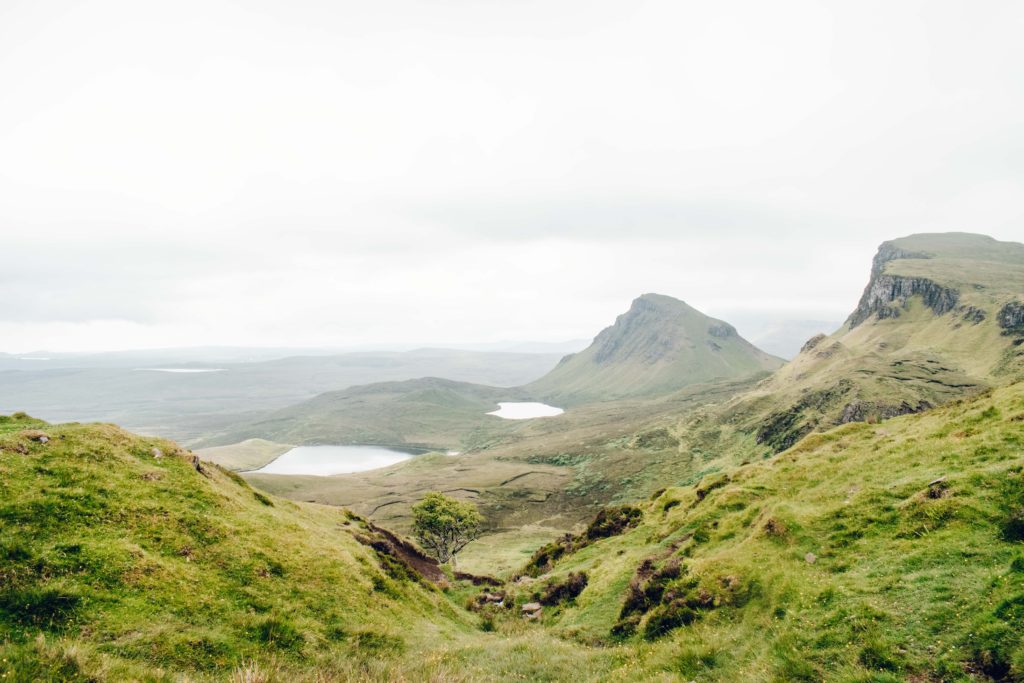
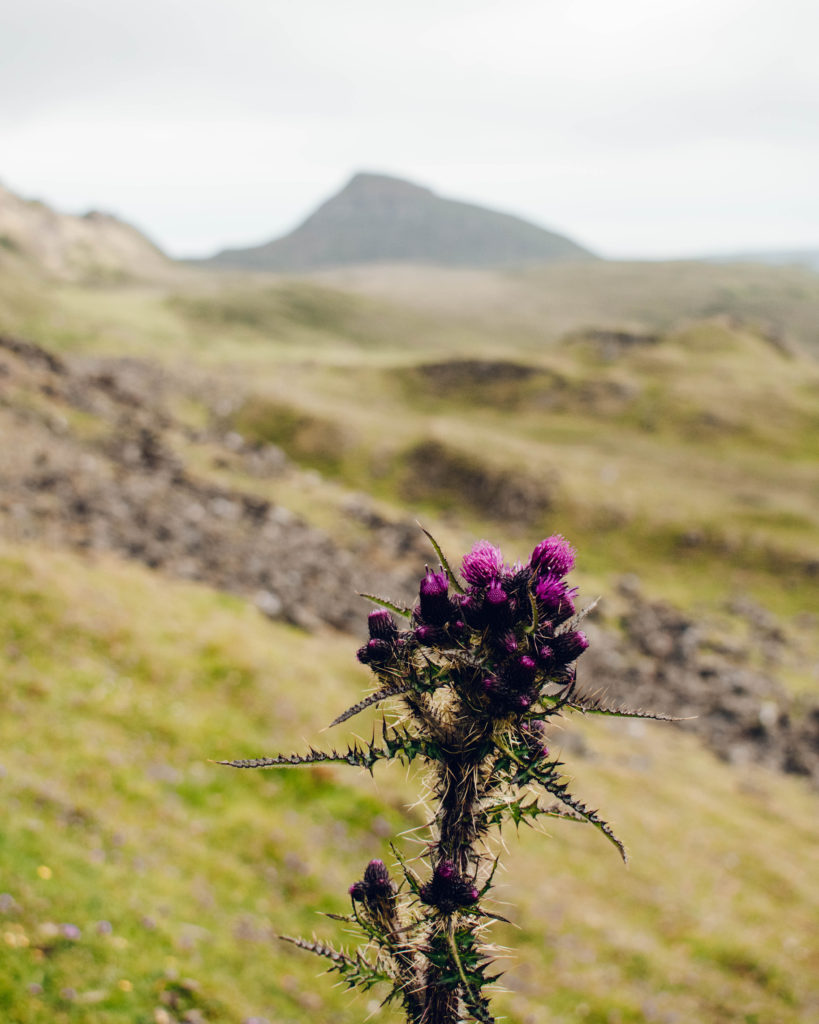
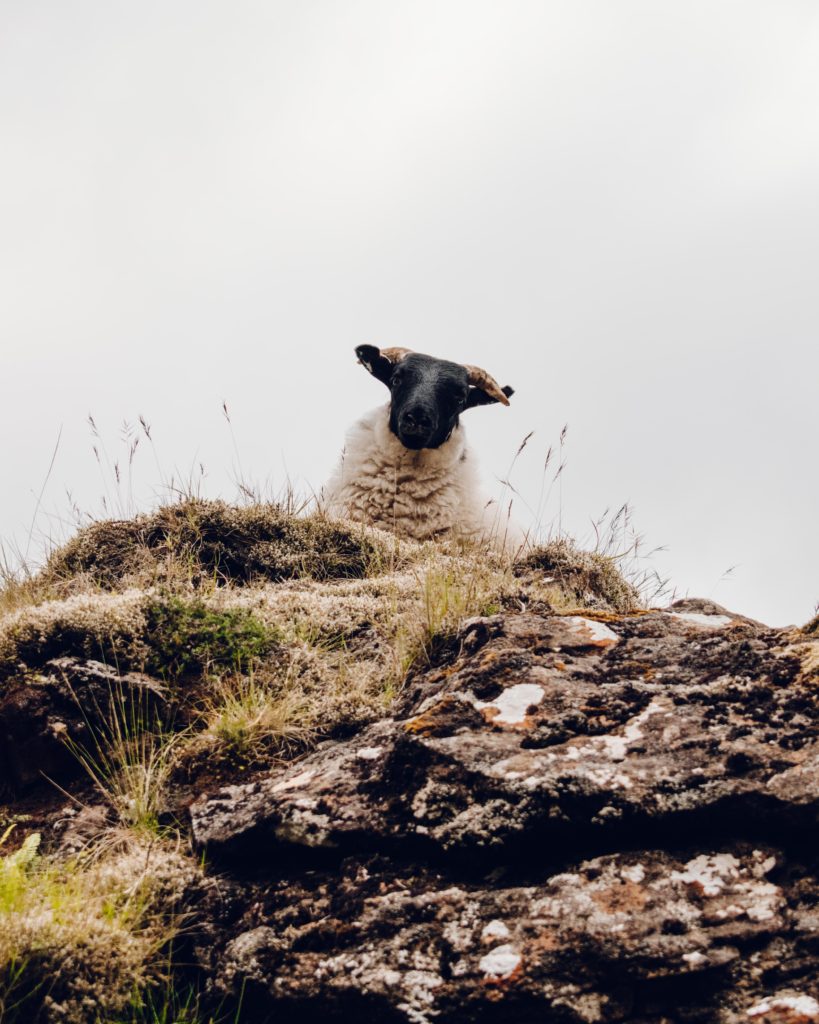
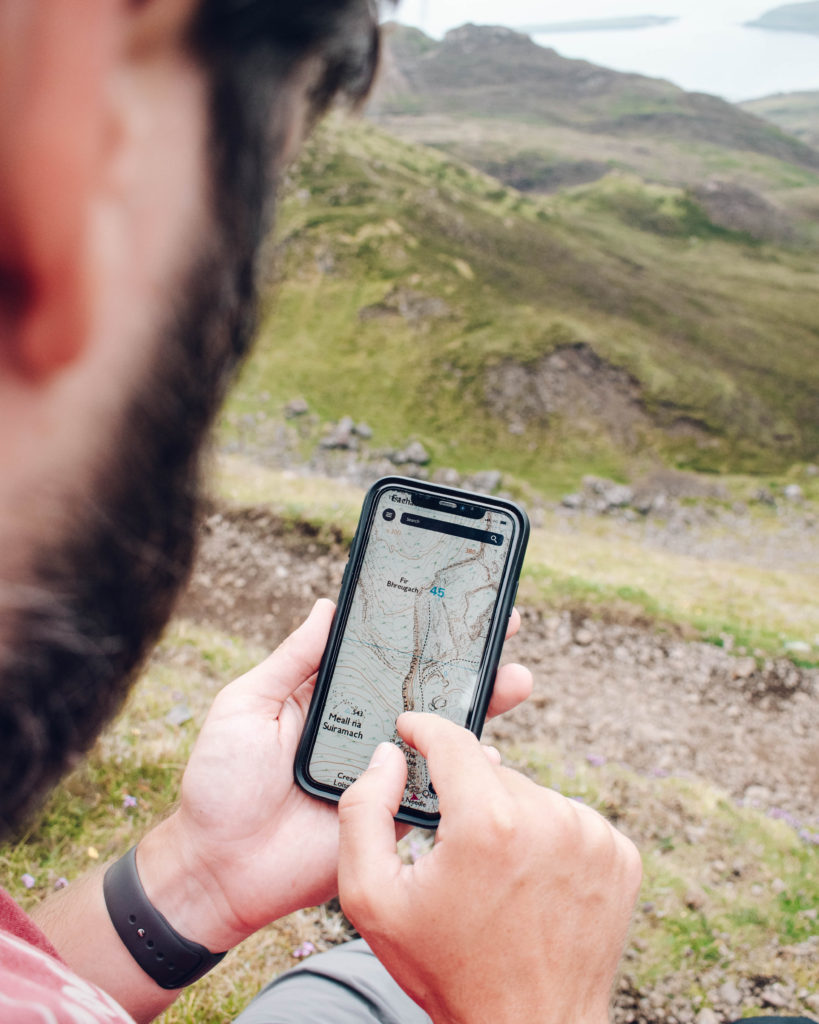
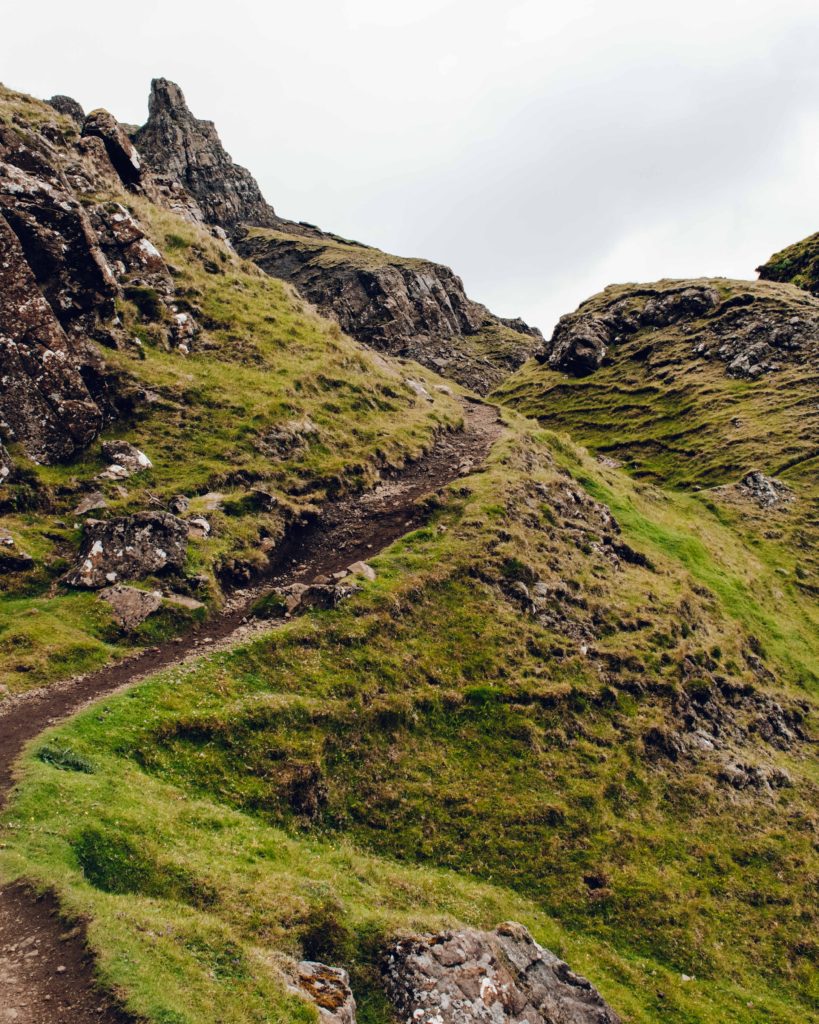
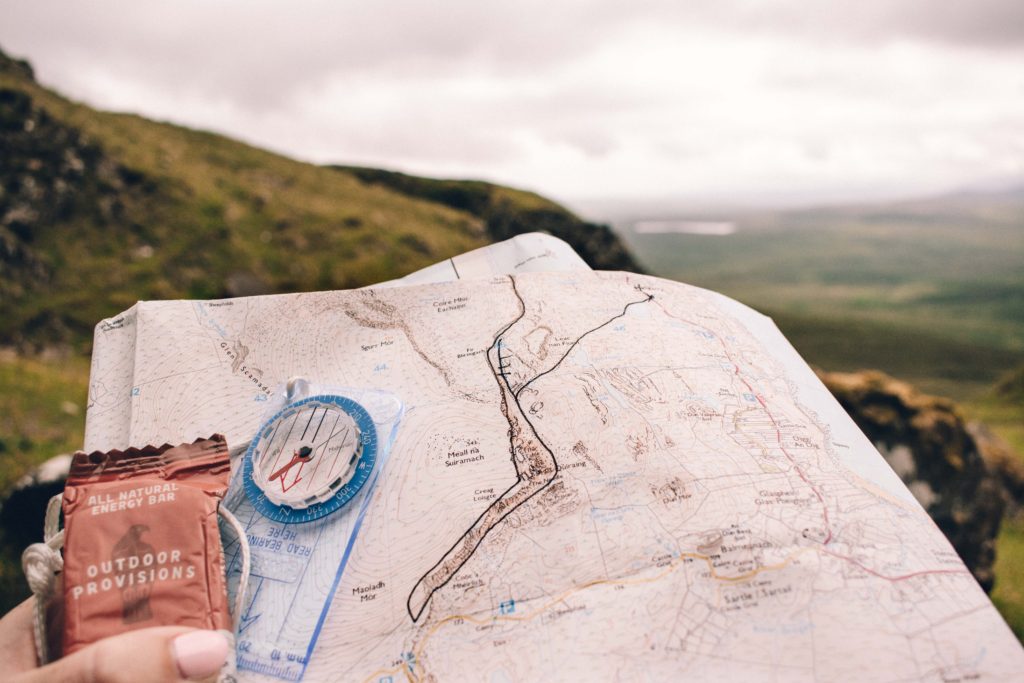
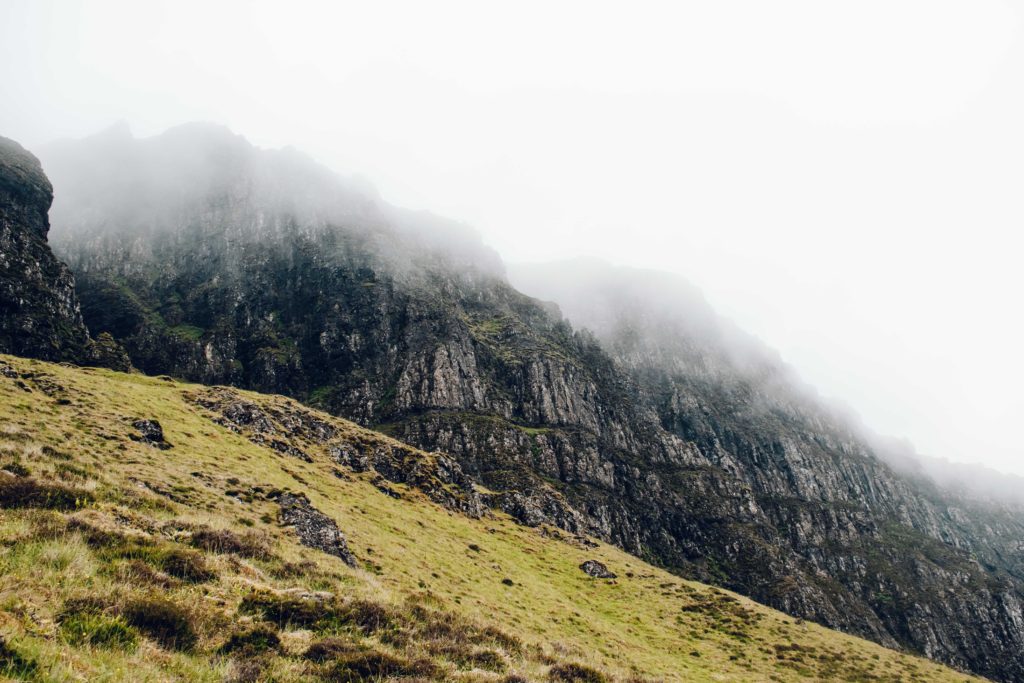
RUBHA HUNNISH
Distance: 5.2miles/8.5km
Ascent: 340m
Difficulty: Easy
Parking: Small grassy area, just off the minor road by the red phone box near Kilmaluag. Space for about 8 cars.
An easy walk to the old coastguard lookout at the northernmost tip of the island. Views out across to Harris on a clear day are lovely and it is one of the best places for wildlife spotting on Skye. The path will feel although it is leading you to nothing but the cliff, but as you get closer to the fence, you will see a small path up over the hill to your right, which will take you to the small hut. The scramble down beyond the hut takes about twenty mins. Although it looks worse than it is, save the scramble for a day when the weather is good as it needs some concentration and gets very slippery when wet.
The hut was once staffed around the clock, monitoring the important shipping channel in The Minch. Now, it is maintained by the Mountain Both Association. Be sure to follow the bothy code whilst visiting.
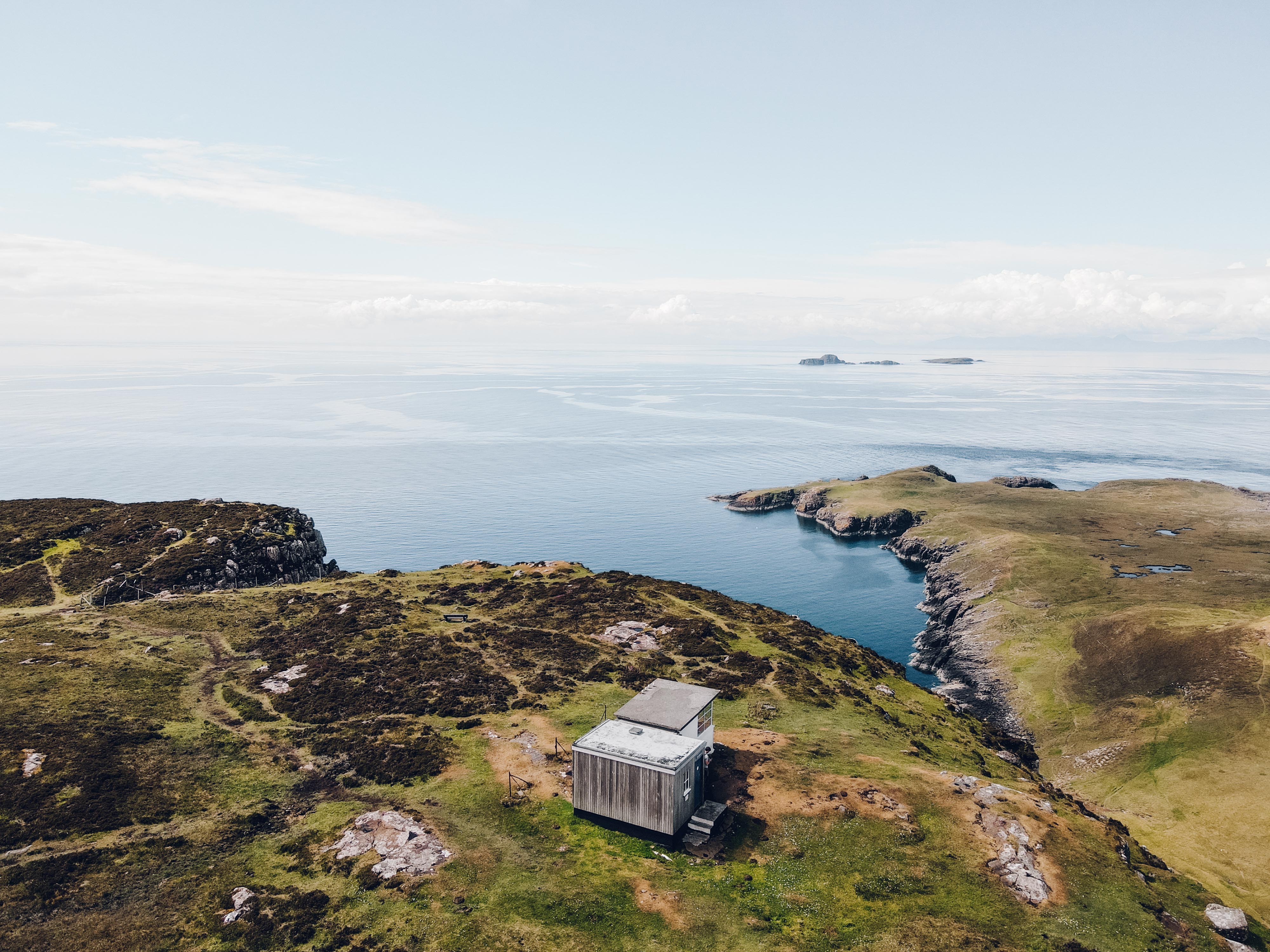
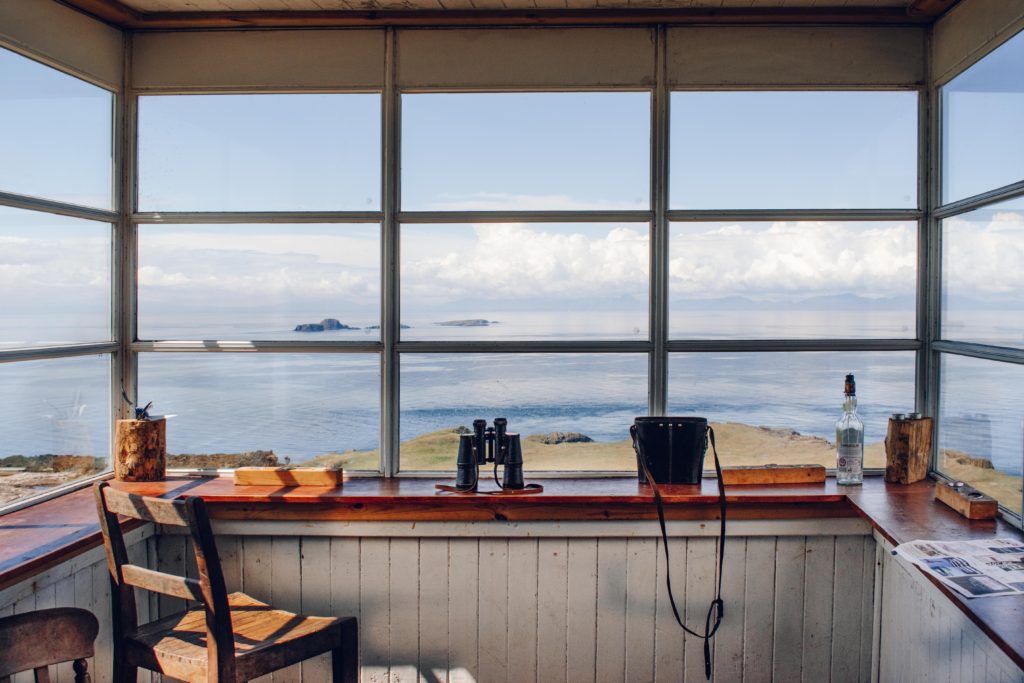
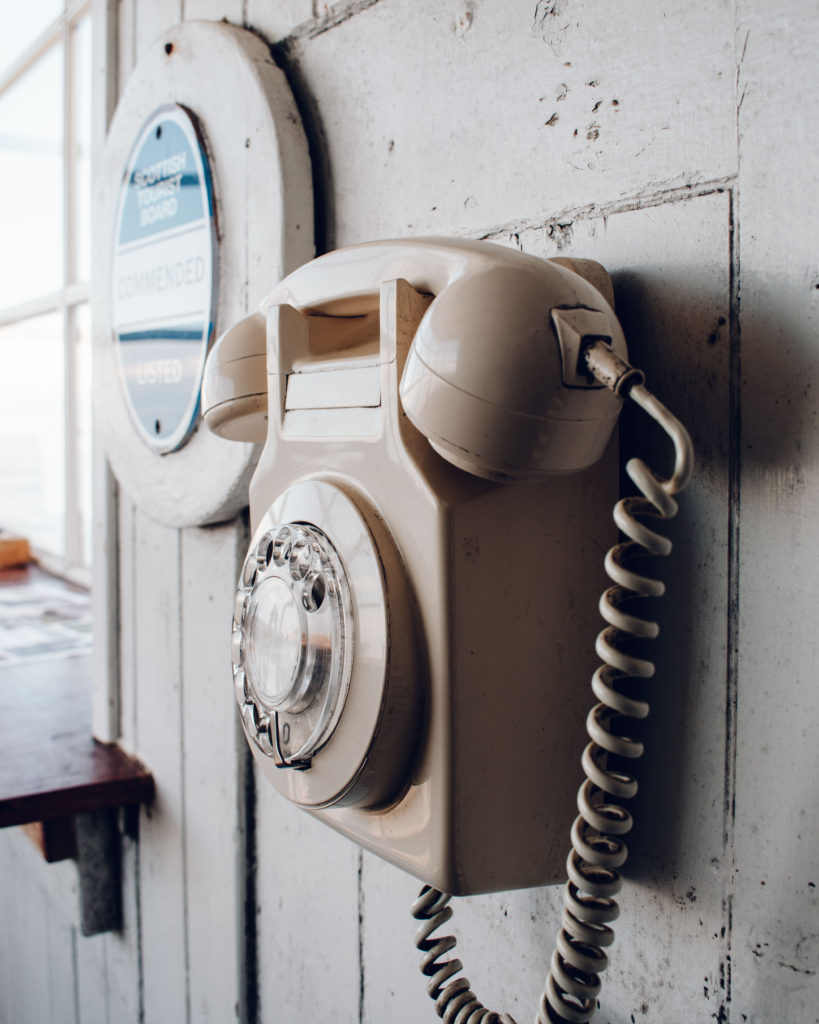
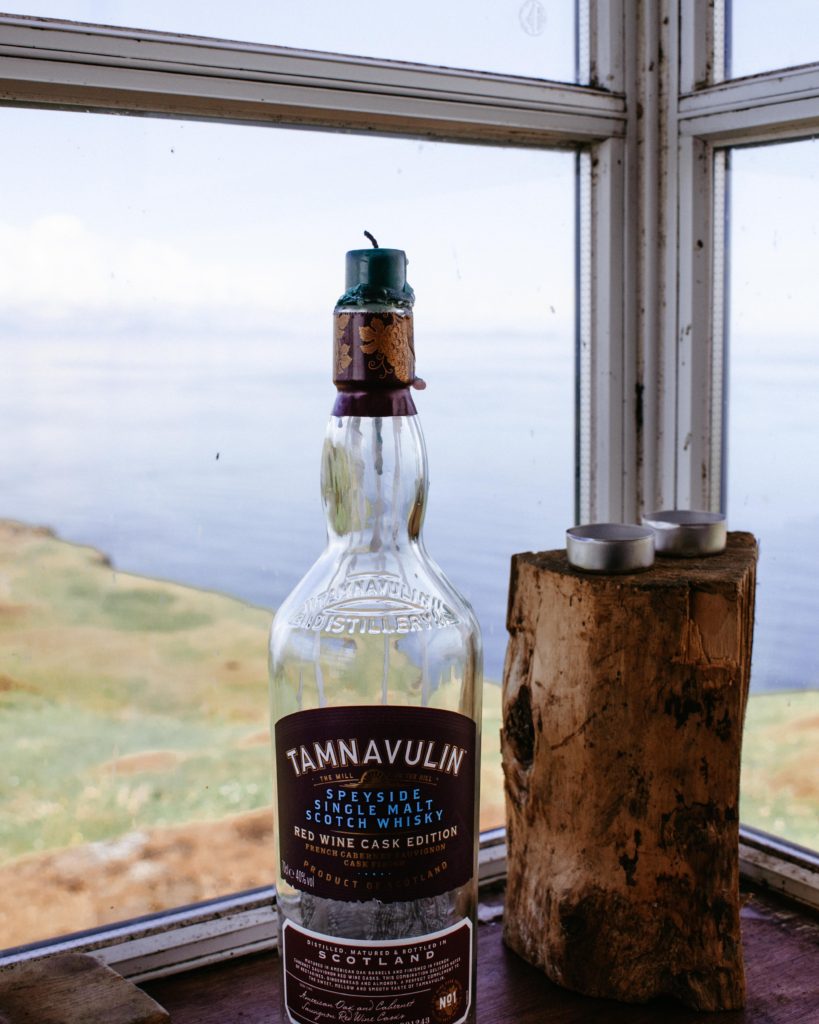
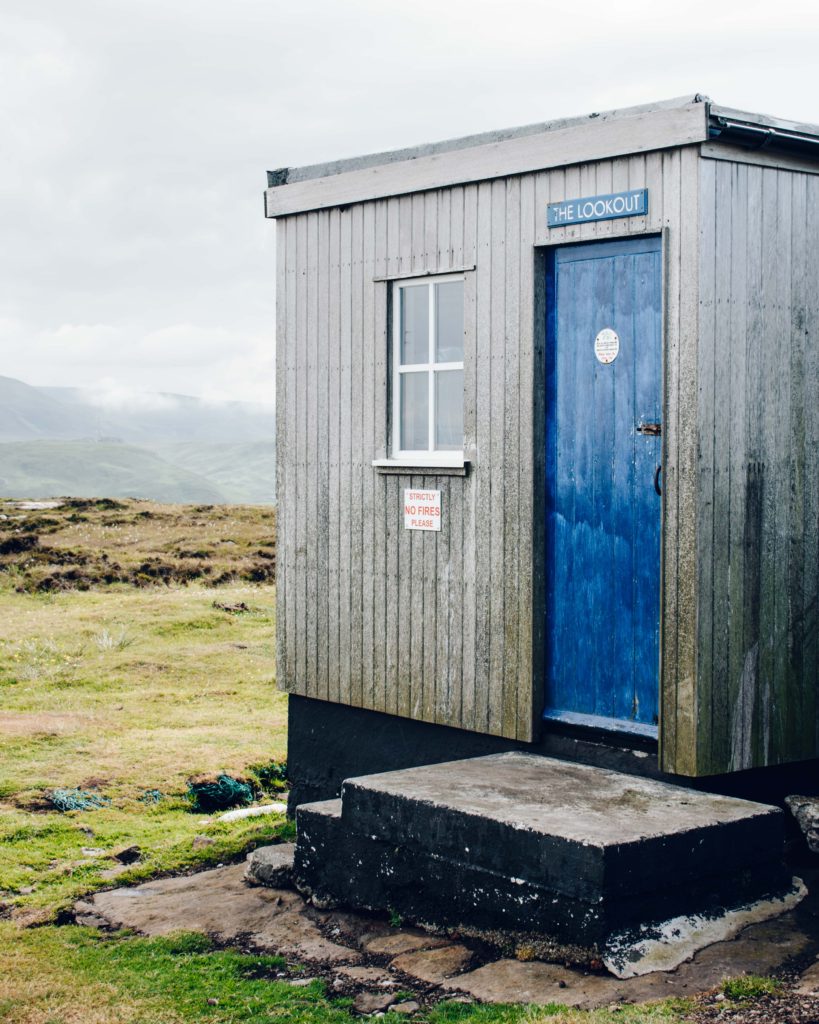
BORERAIG
Distance: 10.25 miles/16.5km
Ascent: 350m
Difficulty: Medium
Parking: Opposite the ruined church of Cill Chrisod, on the road to Elgol
This walk will take you into some of the darker periods of Scottish history. The ruined settlements of Boreraig are a visible reminder of an event known as the Highland Clearances. The residents of Boreraig were brutally cleared from their land in 1853 by Lord Macdonald to make way for more profitable sheep grazing land. As with many thousands of others across the highlands, families were evicted and homes were burned to prevent returns. You will see several other such settlements on this route.
The circular walk is easy, but long, so I would allow around four hours to complete. It starts at the ruined church of Kilchrist (Cill Chriosd) on the road from Broadford to Elgol. From the Church, walk along the road towards Bradford and take the first right after the cattle grid – the turn off is about 250m from where you parked. The path takes you up and over the summit of the pass, before descending back down to the water, from where the path follows the coastline.
For the most part the paths are easy to follow and well sign posted, but they can get boggy.
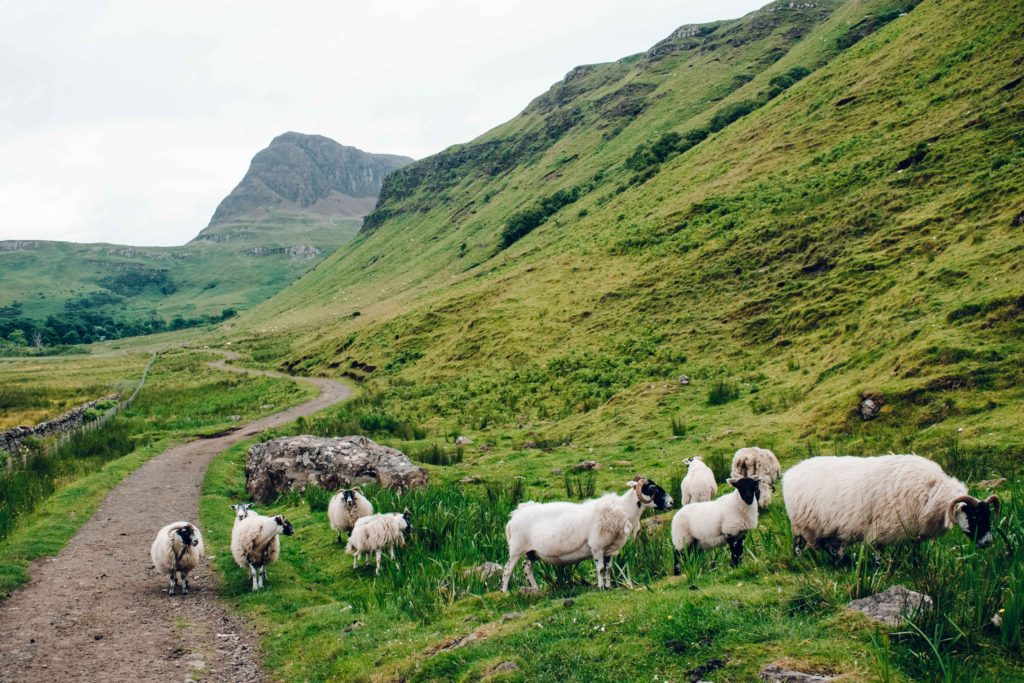
CAMASUNARY BOTHY WALK
Distance: 5.5 miles/9.2km
Ascent: 180m
Difficulty: Medium
Parking: Large layby just after Kilmarie on the Elgol road. Space for about ten cars.
Map
This lovely there-and-back walk offers a taste of the Cuillin Hills, but without anything too challenging and without the need for ninja navigation and map skills! Best saved for a clearer day when the ridge is visible, but even without the views it is still a lovely walk.
The walk starts just across the road from the carpark, through a small wooden kissing gate – there is a green sign confirming you are on the right path! The path heads up to the top of the moor, becoming progressively rougher, and loose gravel underfoot, as you go. From the top of the moor, you will get your first view of Camasunary Beach to the left, and straight ahead are the Red Cuillins and the more jagged ridge of the Black Cuillins.
You could choose to stay in the recently restored bothy by the beach. It has two rooms – one for sleeping, one for eating. There are wooden sleeping platforms, and also bench-like sleeping platforms. The bothy can accommodate about 15 people. Alternatively, head back along the same path to return to the car park – allow about three hours for the total walk.
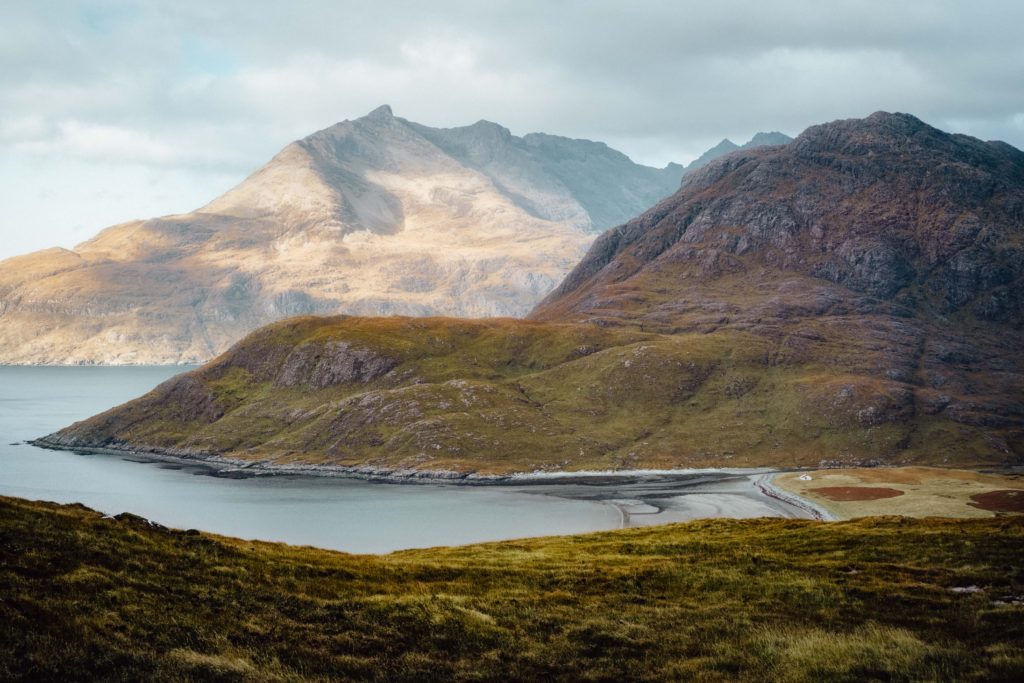
COIRE LAGAN
Distance: 5.5 miles/9km
Ascent: 590m
Difficulty: Challenging
Parking: Glenbrittle Campsite
Really great introduction to the Cuillins, and probably my favourite walk on Skye. The walk starts just to the left of the campsite toilet block, through a small gate. A very well maintained, well cut path immediately starts to head steadily uphill. Although the gradient does not get too mean, the path continues to climb for the duration of the walk. The short section of around 20 metres of scrambling at the top is so gentle, it only just edges into a scramble as you need to use your hands for stability!
The small loch at the top is perfect for a – chilly – swim, and there are a lovely series of shallow pools and waterfalls just before the summit. If visibility allows, there are great views of the summit of the Cuillins. The scree slopes to the left of the loch are topped by the spire of the aptly named Inaccessible Pinnacle, considered the UK’s most difficult mountain, although you can’t see the summit. To the right is the peak of Sgùrr Mhic Chòinnich. Further along is Sgùrr Thearlaich, a summit only accessibly by rock climbing, and Sgùrr Alasdair, the highest non-mainland mountain in Britain.
On return, you can either come back the way you came up, or turn right at the cairn you passed on the way up, to form a loop back past the Eas Mòr falls.
Glenbrittle beach is nice for a stroll post walk – ideally with a coffee and muffin from excellent the campsite café!
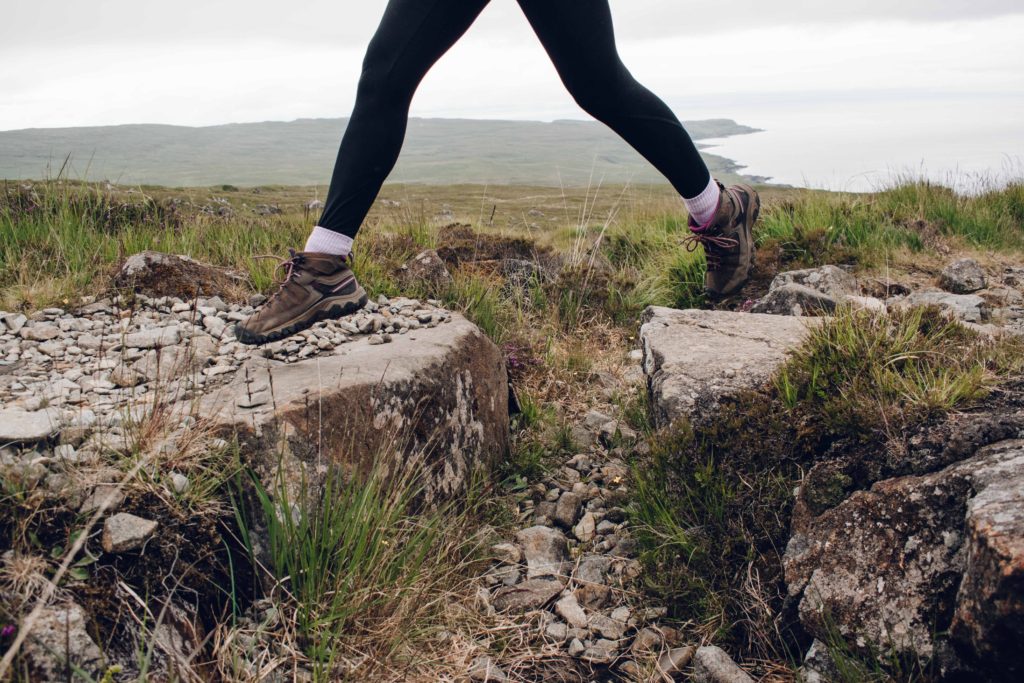
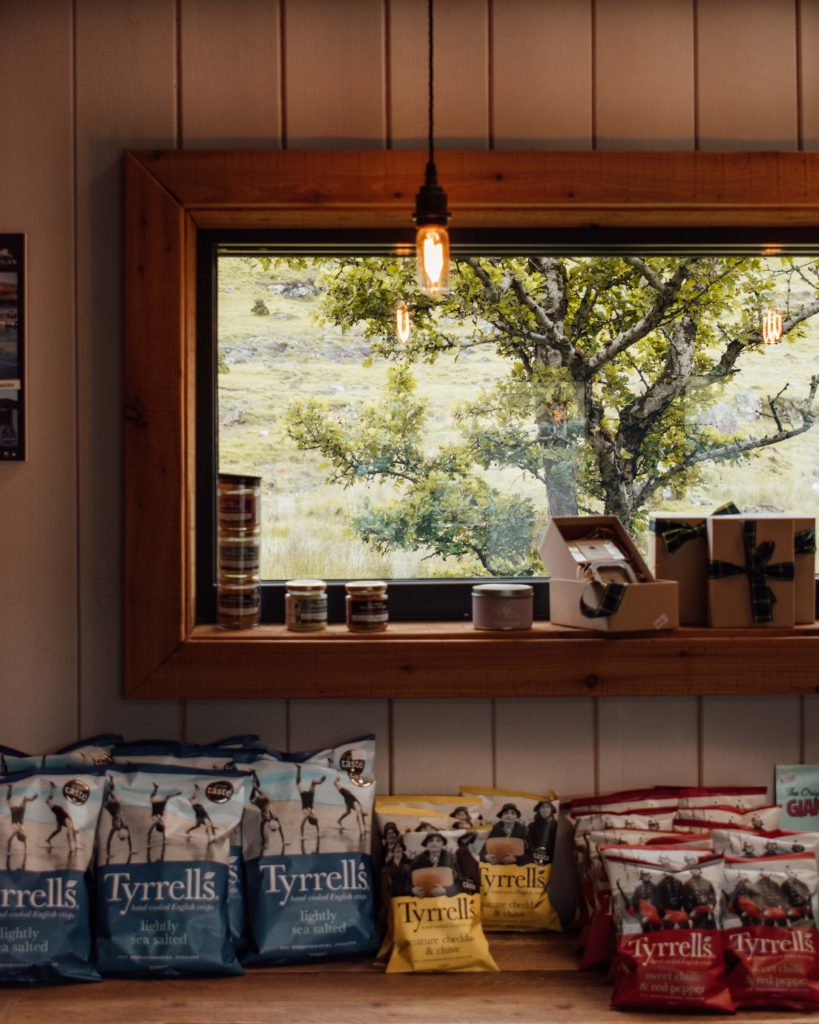
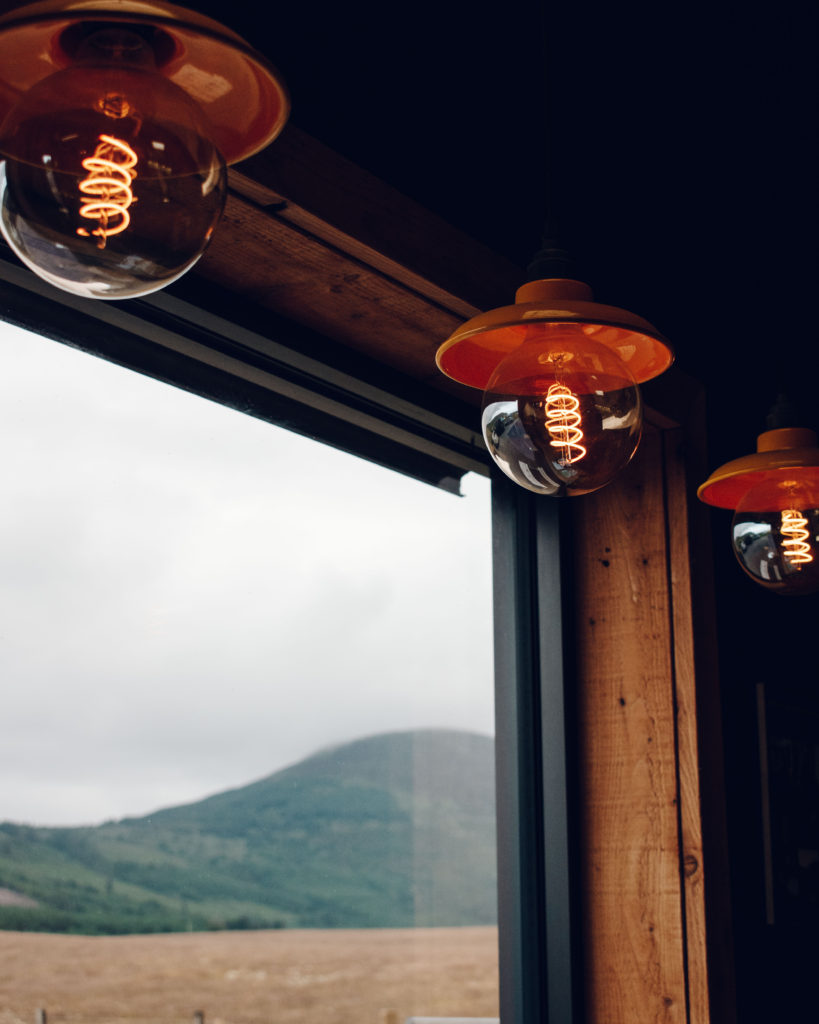
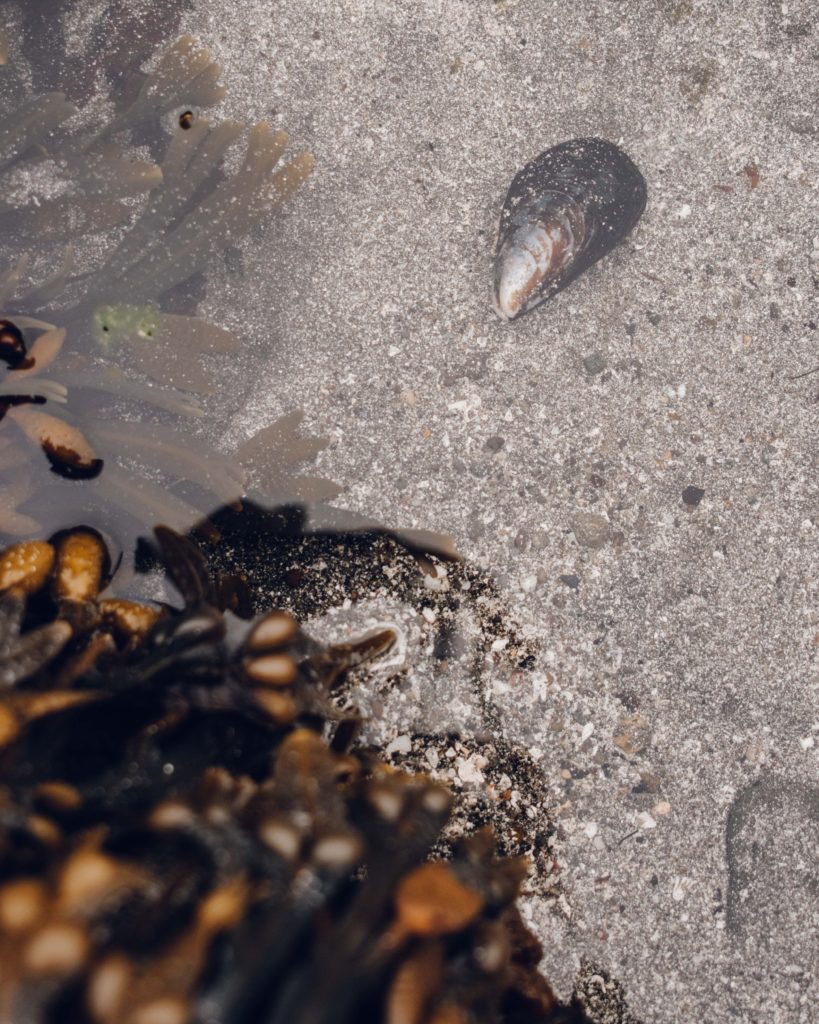
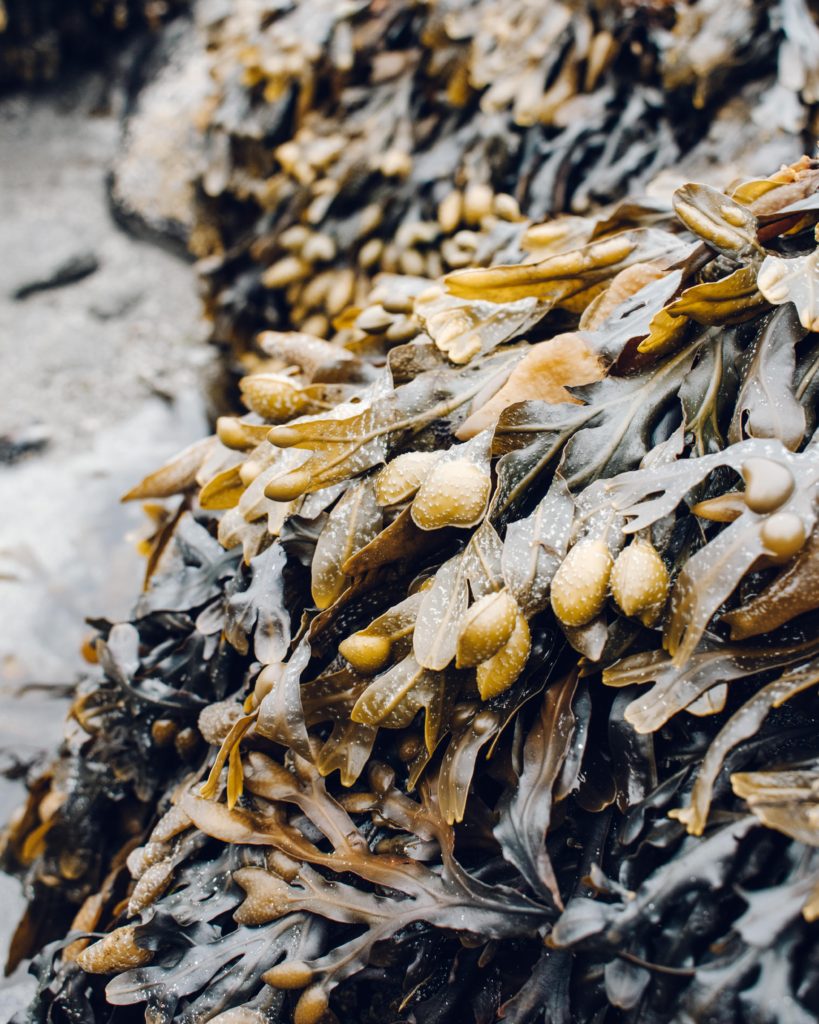
BLA BHEINN (BLAVEN)
Distance: 5 miles/8km
Ascent: 990m
Difficulty: Strenuous
Parking: Coming from Broadford, just after the bridge over the Allt na Dunaiche, there is a signed track pointing to the car park.
The big one! Full, 360 views of the Black Cuillins await at the top and by the time you get there you will really have earned them. Repeatedly topping the list as one of the best walks on Skye, it involves some minor scrambling and a good head for heights.
The scree and boulders can make the final sections pretty hard going, and tricky to follow so be sure to check out recent walk reports for the best routes and tips before you set off. You will want to be confident in your map reading skills to complete this walk. I’d also keep it for a clearer day, as finding your way in the mist will become less and less enjoyable (as we found out on our last attempt at the summit!). Besides, the reward is the view!
There are also some really wonderful swimming spots on the route, so take a swimming costume – or prepare to brave an exhilarating skinny dip as we did! And at the end of your walk head to Mrs Mack’s hot food truck, just over the loch outside of Torrin. The lovely owner Sara serves well earned hot rolls.
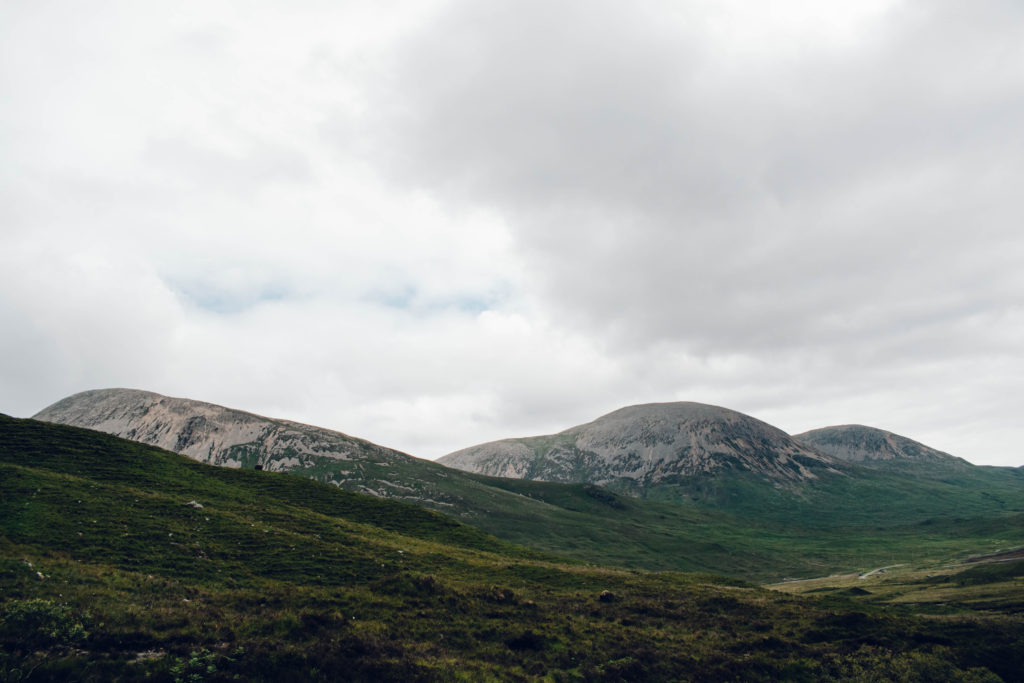
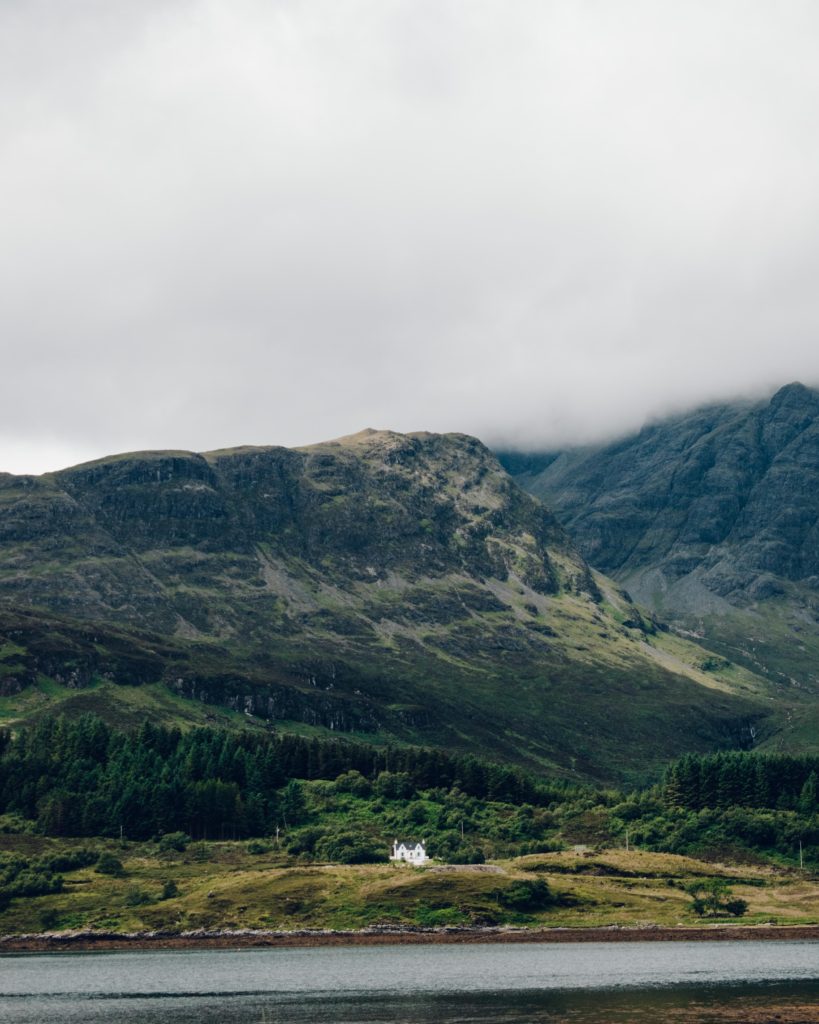
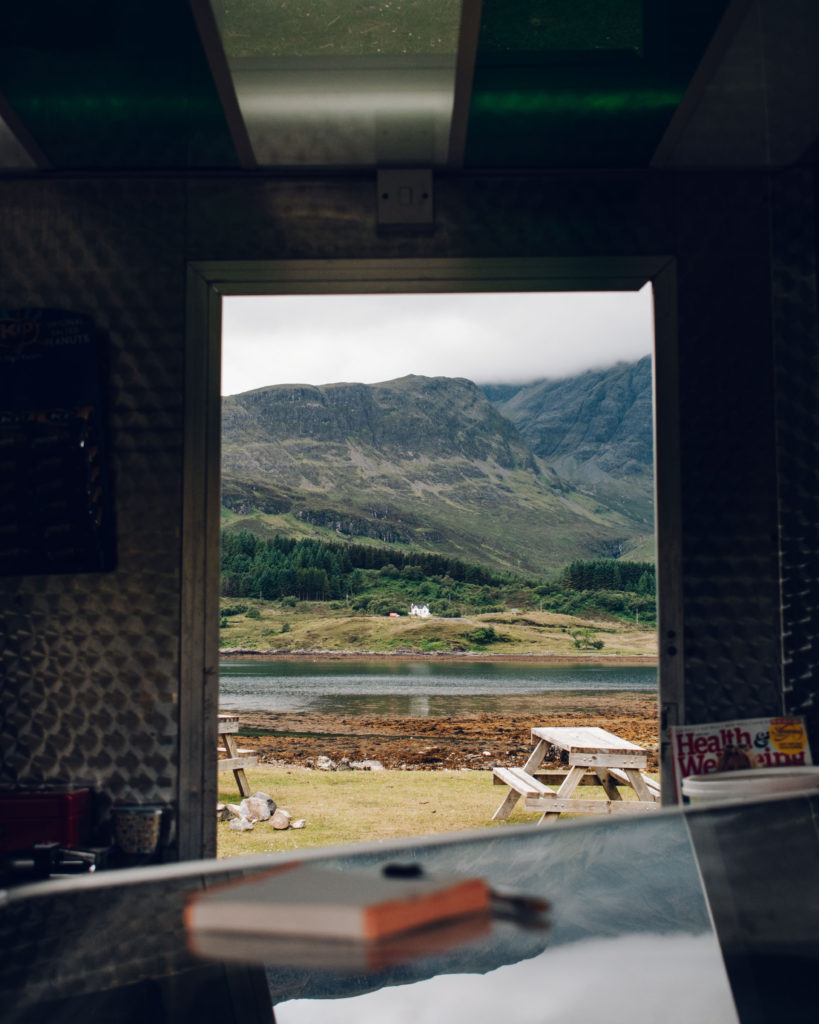
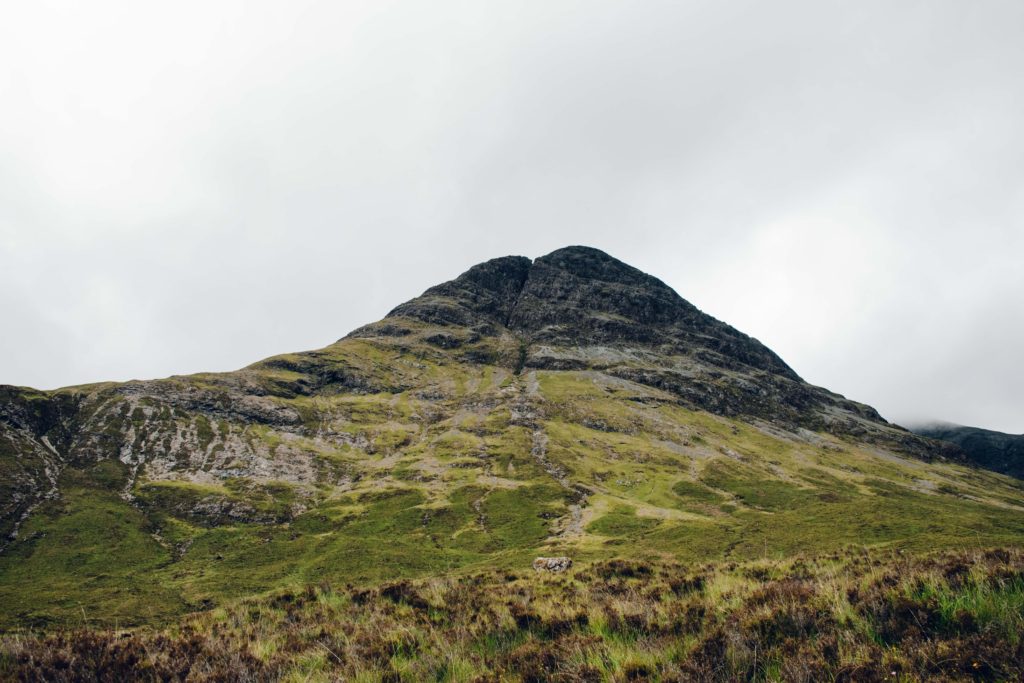
RAINY DAYS
Skye is primarily a destination for the great outdoors, but the island also has a fair share of historical and cultural attractions that you might want to see on a rainy afternoon – or perhaps a day to give the feet a rest before your next big ascent!
Portree – Skye’s main town, with its pastel coloured houses lining the harbour front, has a really lovely vibe. There is a buzzing, café/bar culture and a growing range of independent, boutique shops to explore. I particularly liked the sleek Òr and the quirky, colourful Skye Batiks. The superb Inside Out has a fantastic range of outdoor kit and camping essentials. Birch Café is the top pick for a caffeine hit.
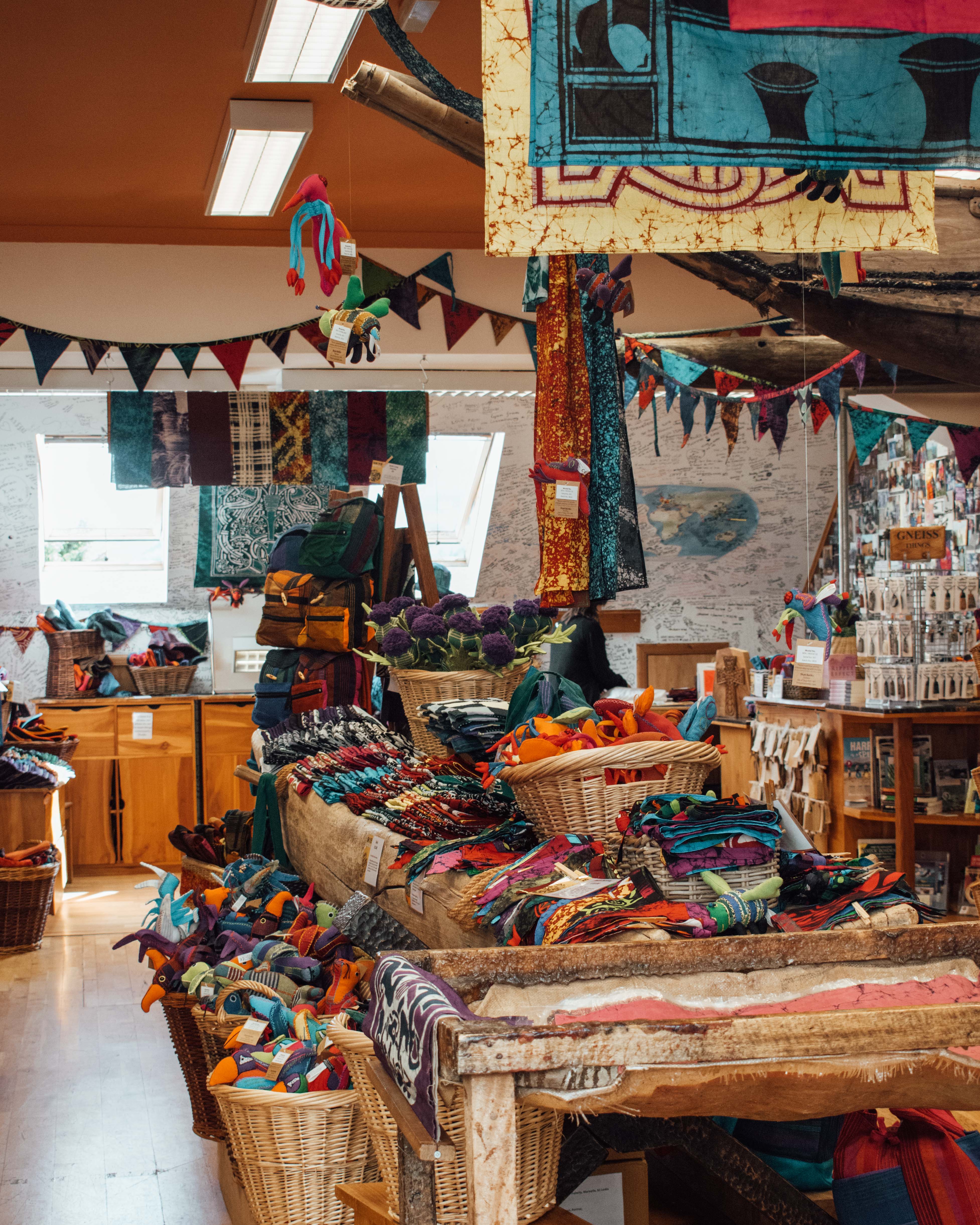
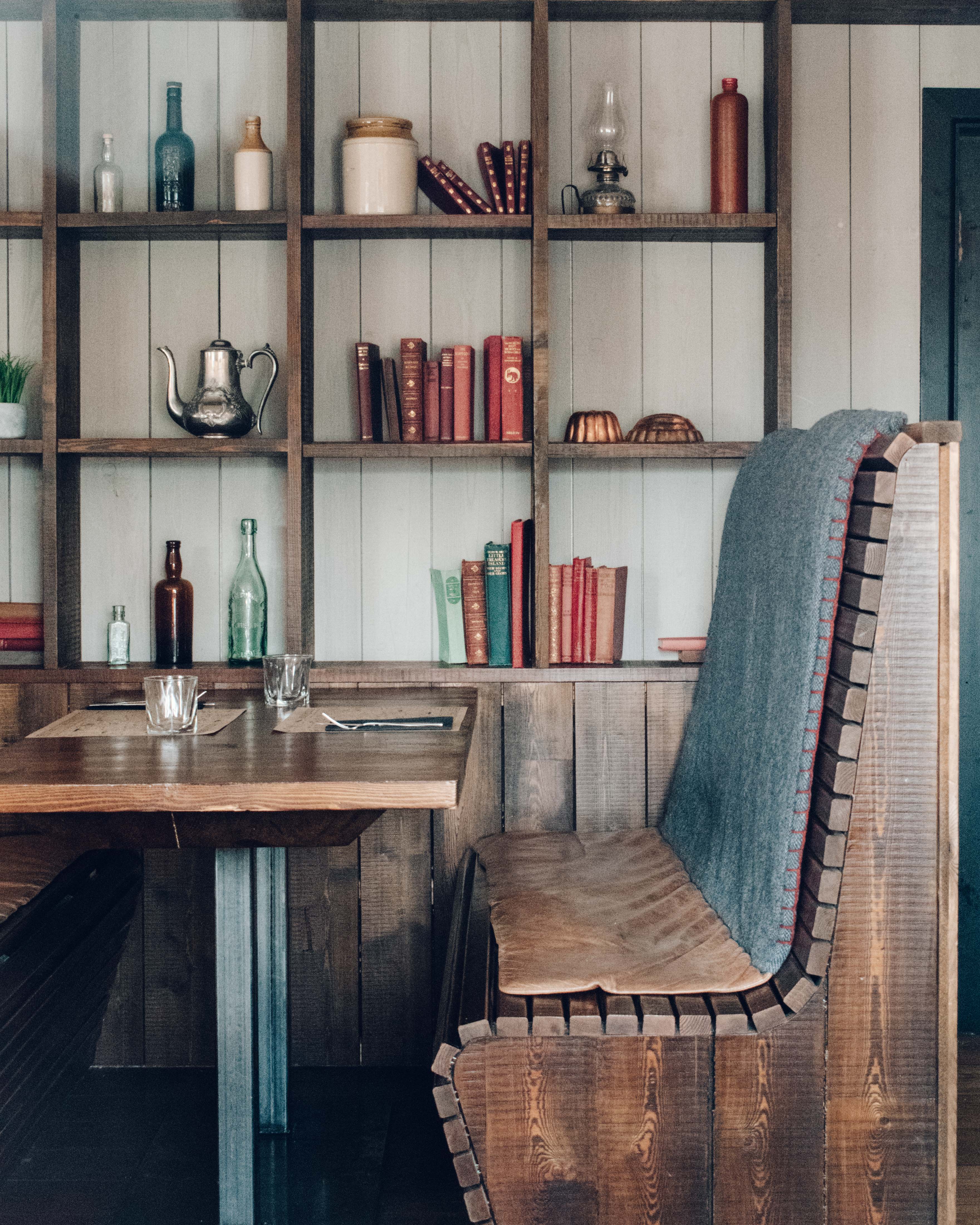
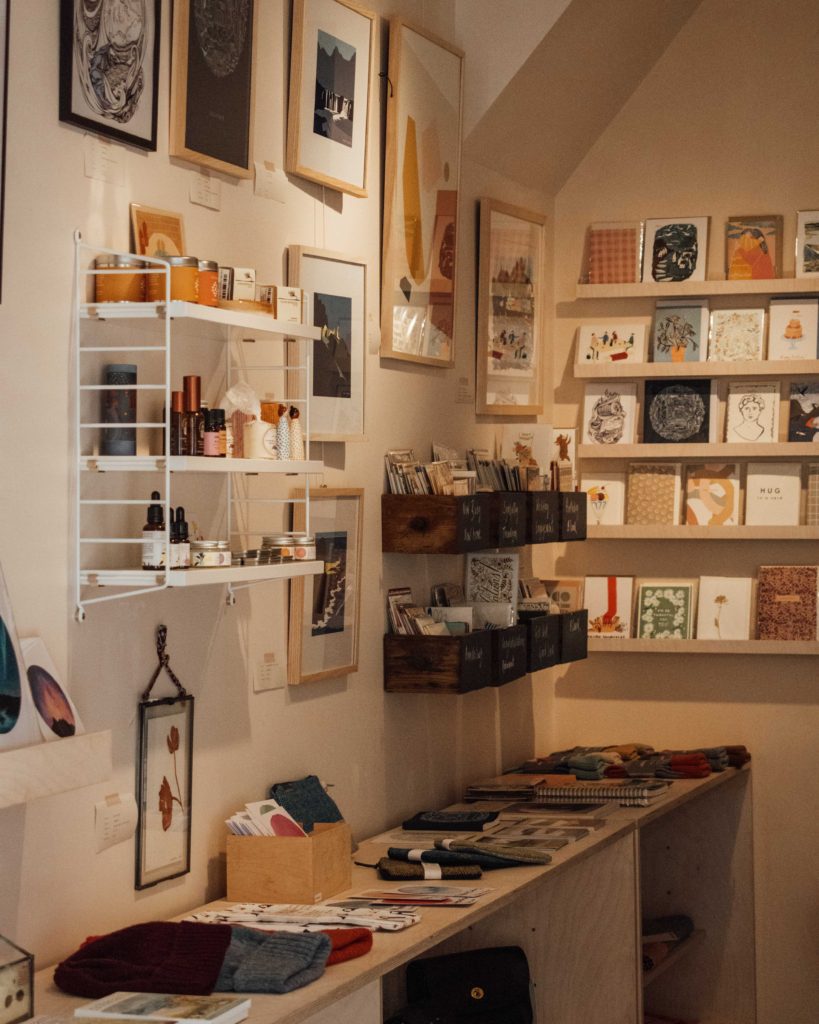
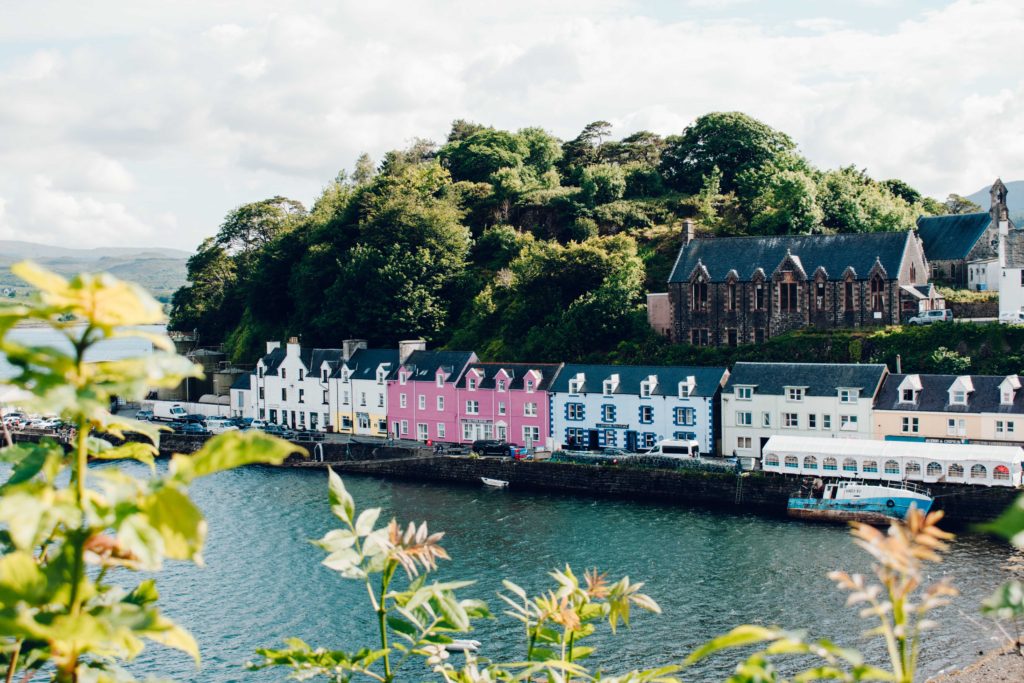
Dunvegan Castle * – the ancestral home of Clan MacLeod occupies a dramatic spot on the edge of the water, and has been continuously occupied by the same family for over 800 years. The beautifully manicured, formal gardens are quite the contrast to the surrounding wild landscapes and the inside of the castle has been sensitively restored. Tickets are £15 for the castle and garden; £12 for the gardens only.
Skye Museum of Island Life – this small museum near Uig offers an insight into life on the island a hundred years ago. Several restored cottages showcase different aspects of life, from crofting to social gatherings. It is open from Easter to late-September, and tickets cost £5.
Bonnie Prince Charlie
“Speed bonnie boat like a bird on the wing,
onward, the sailors cry.
Carry the lad that’s born to be king
over the sea to Skye.”
Charles Edward Louis John Casimir Sylvester Severino Maria Stuart, most commonly (and understandably) known as Bonnie Prince Charlie, was the grandson of the deposed Catholic King James VII of Scotland and II of England. He and his followers believed the throne of Great Britain rightfully belonged to the House of Stuart, and led the campaign known as the Jacobite Risings of 1745-46, to overthrow King George II. His eventual defeat at the Battle of Culloden in April 1746 effectively ended the Stuart cause, and the Prince was forced to flee Scotland to avoid capture by the Hanoverian troops.
The well known 19thC ballad, The Skye Boat Song, commemorates the journey of Bonnie Prince Charlie to the Isle of Skye during his escape. He was assisted by Flora MacDonald, who’s benefactor was a Jacobite sympathiser. She disguised him as her maid – Betty Burke – and helped to smuggle him out by boat.
Historians continue to debate the extent to which Flora was a fully willing participant in the escape. Although the MacDonalds were sympathetic to the Jacobite cause, Flora herself was a Presbyterian. She initially refused to help, fearing that her family would be punished if her attempts to help the prince were discovered. She later claimed that she acted out of charity, telling the Duke of Cumberland, son of George III, that she would have done the same for him if he had been in Charles’ position.
Shortly afterward the prince’s escape, Flora was imprisoned in London, but was soon released and quickly immortalised as a somewhat romanticised figure. She emigrated to North Carolina with her husband, who fought for the royalists in the War of Independence, before returning to his ancestral home on Skye. There is a memorial to Flora behind the Museum of Island Life.
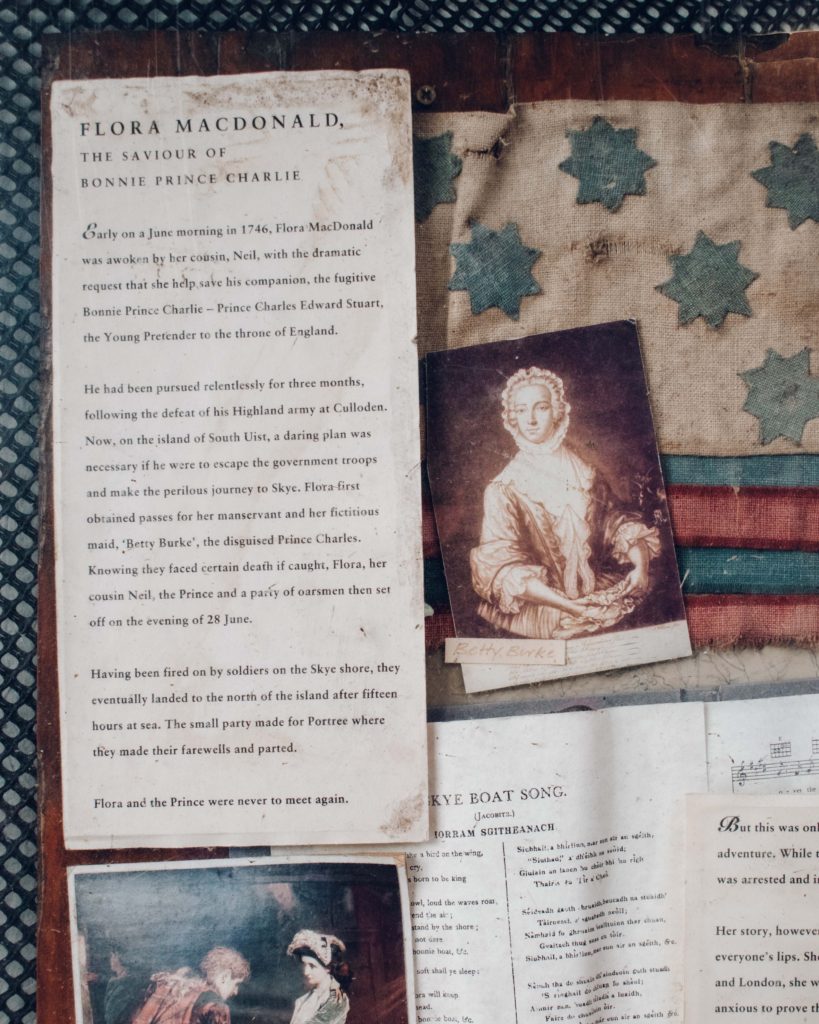
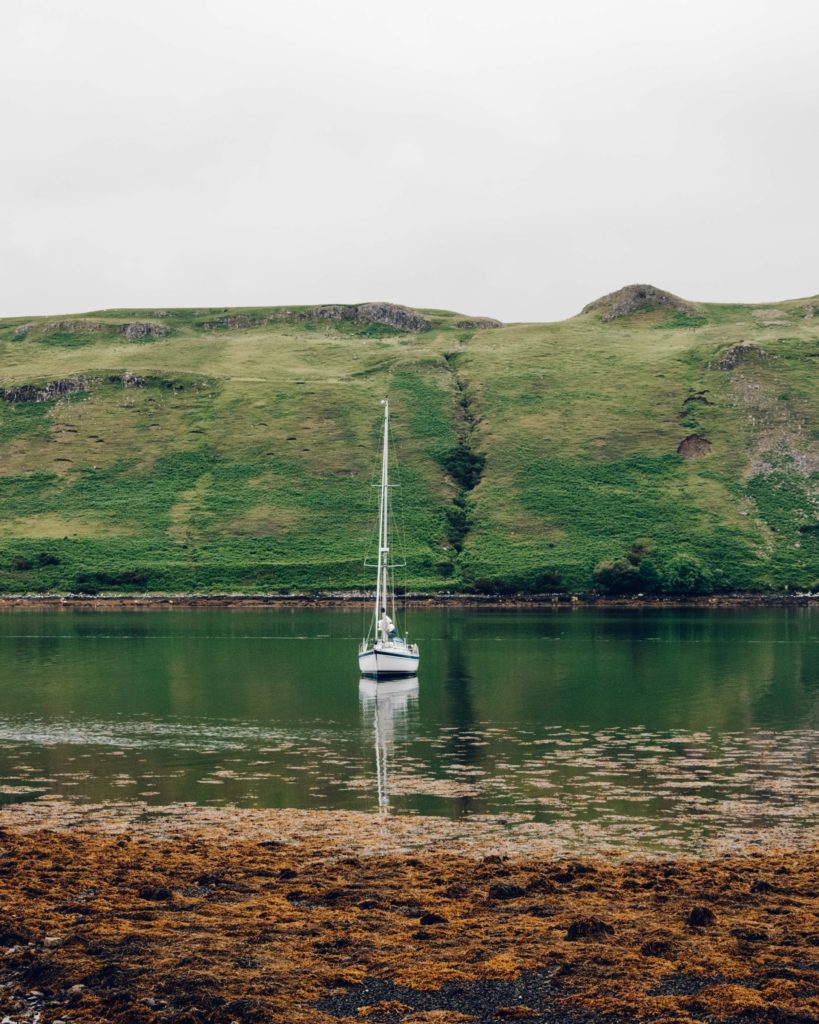
Sample the golden spirit – whisky distilling has been big business across the highlands and islands for several hundred years, and there are two distilleries you can visit on Skye and one more very nearby!
Talisker Distillery * is the most famous, occupying an idyllic spot on the edge of the village of Carbost, in the west of the island, surrounded by hills and stunning views across Loch Harport. It was established by brothers Hugh and Kenneth MacAskill in 1830. Along with Dunvegan Castle, the distillery is Skye’s most popular paid attraction, with around 90,000 people visiting each year. Tours start from £15. Even if you don’t like whisky, it is an interesting experience to see the many years of experience that have gone into crafting such a finely honed process. Tours book out in advance, so buy your tickets online before you travel.
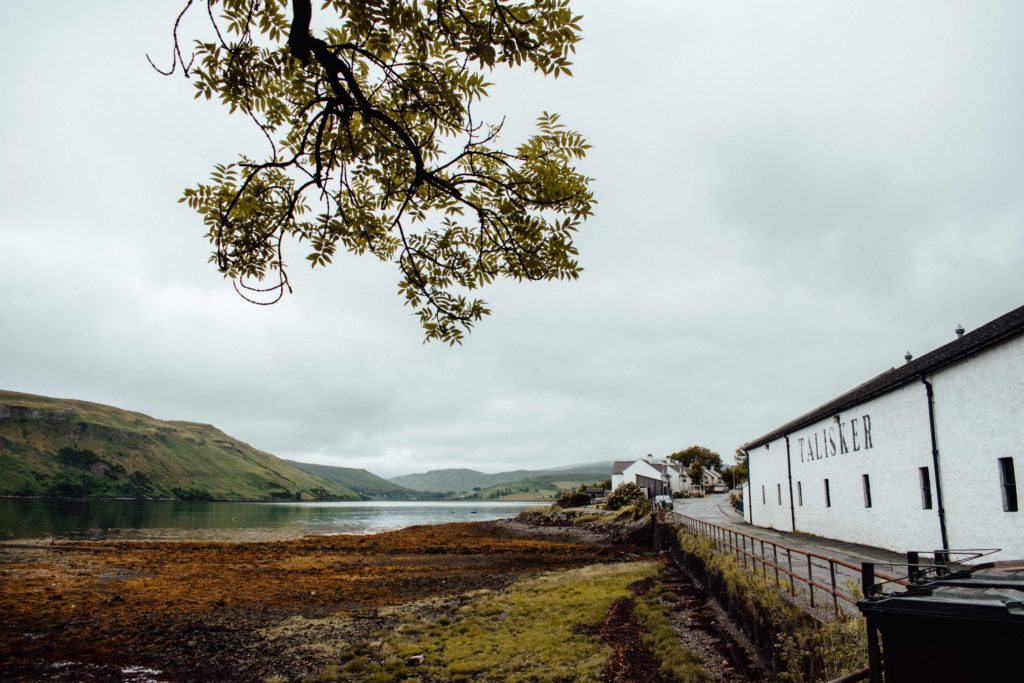
For almost two centuries, Talisker was the only (legal!) distillery on Skye, but in 2017 it was joined by Torabhaig. This newbie has a cool, community focused vibe, with its team of nine young, local distillers never having worked in a distillery before! Tours cost £10.
One of my personal favourites – new kid on the block, Raasay Distillery – produces whisky and gin just across from Skye on the small island of Raasay. Opened in 2017, the makers like to say that this is the first legally distilled whisky from the island after many years of illicit brewing! If you are looking for a slightly different experience, I would really recommend getting the 10-15 minute ferry across from Sconser to stay overnight at the distillery’s own B&B and sample their produce. Tours are £10.
Breweries – and if whisky isn’t your thing, The Isle of Skye Brewery and the Cuillin Brewing Co produce a selection of craft lagers, ales and session IPAs. Faraway Dispatches chief beer connoisseur (The Husband) personally recommends The Skye Red Amber Ale.
WHERE TO EAT
During peak summer months you will need to make reservations ahead of your trip if you want to get into most restaurants or food-serving pubs. Many cafes will offer takeaway options if you are unable to get a table.
Oyster Shed – freshly cooked seafood and chips! Very generous portions, and if more than two of you (or one hungry Husband…) the seafood platter is fantastic value. Also sells a range of deli items. Bit of a Skye institution, so gets extremely busy and parking is utterly chaotic!
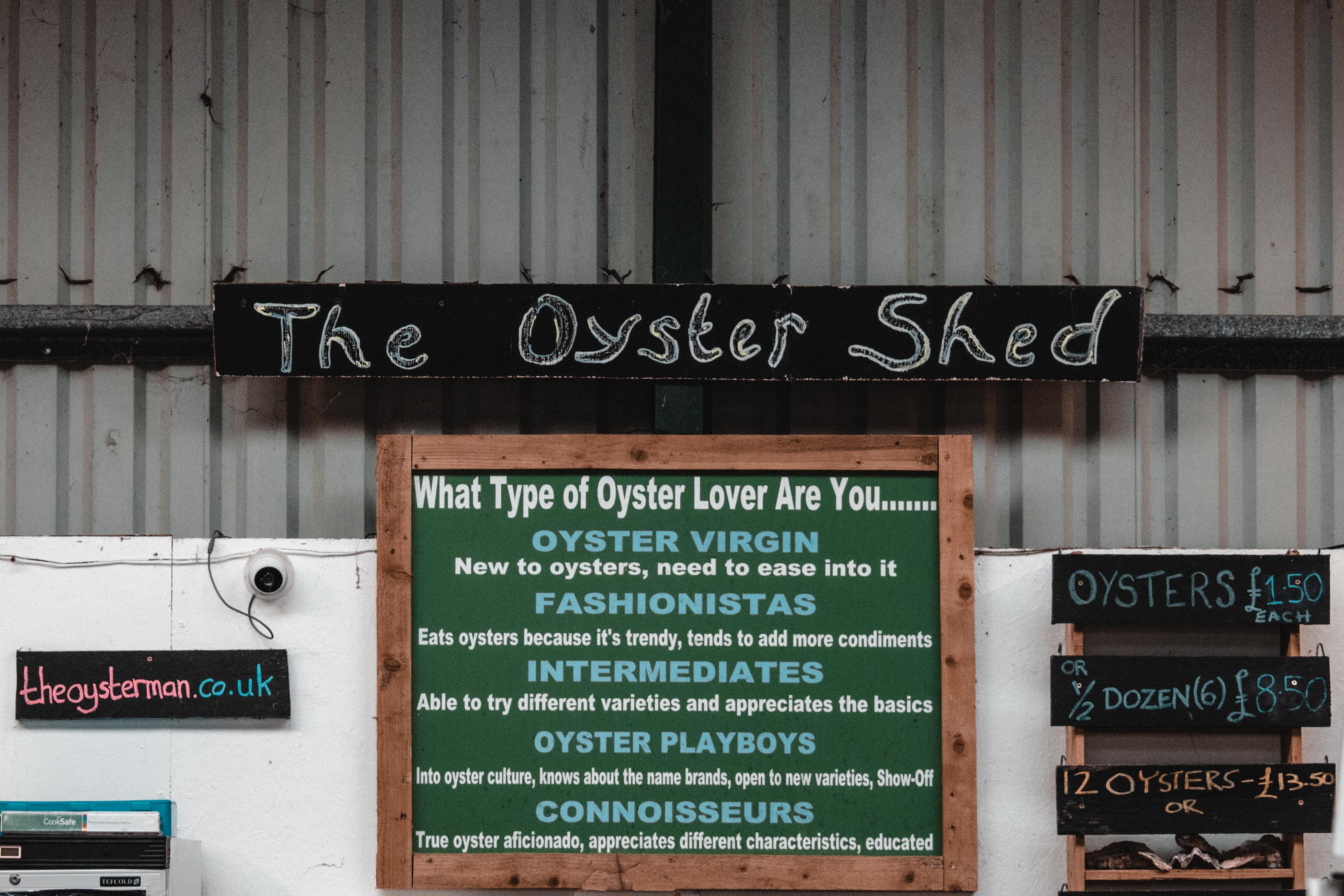
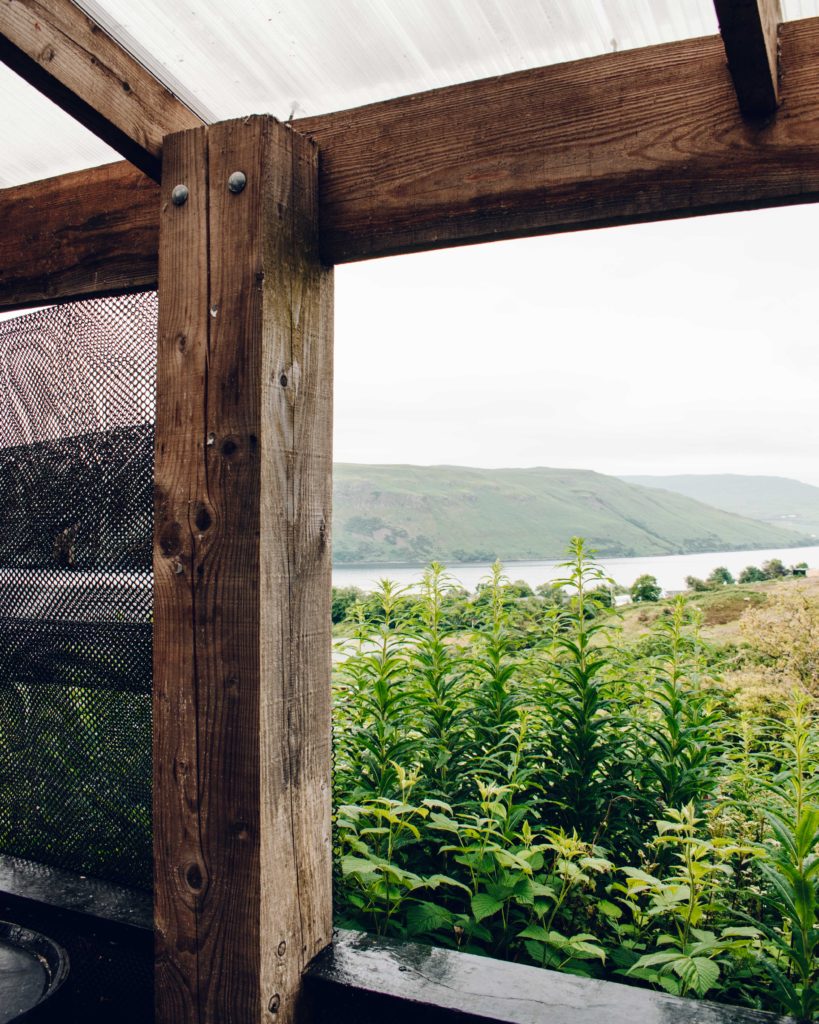
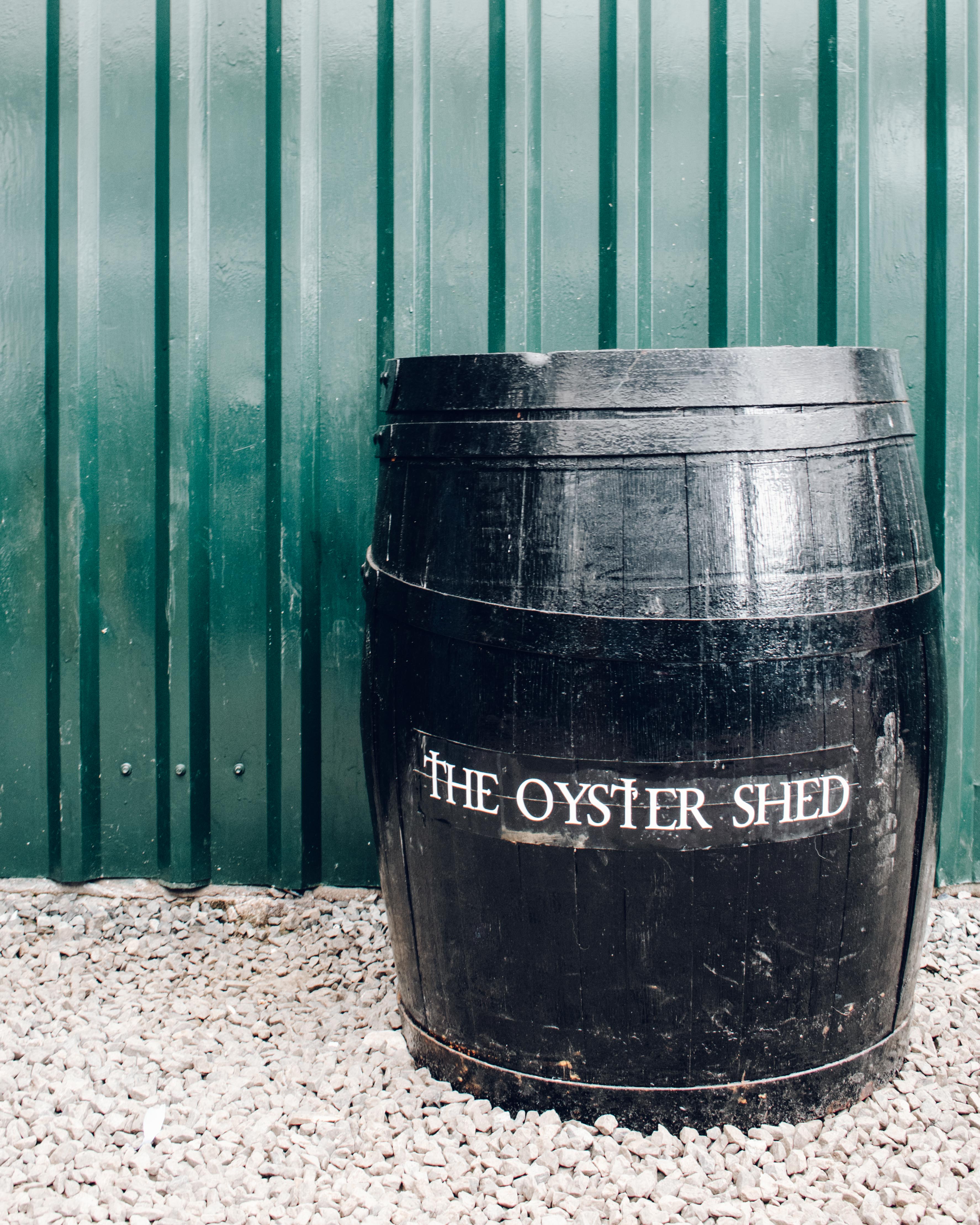
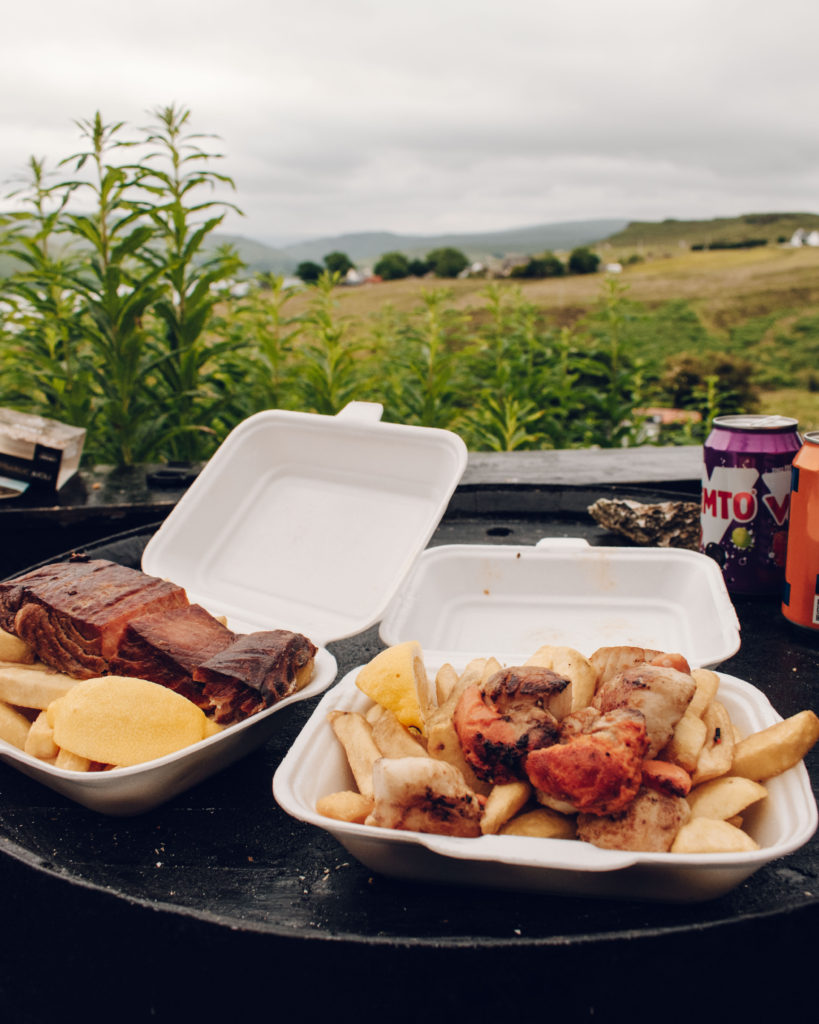
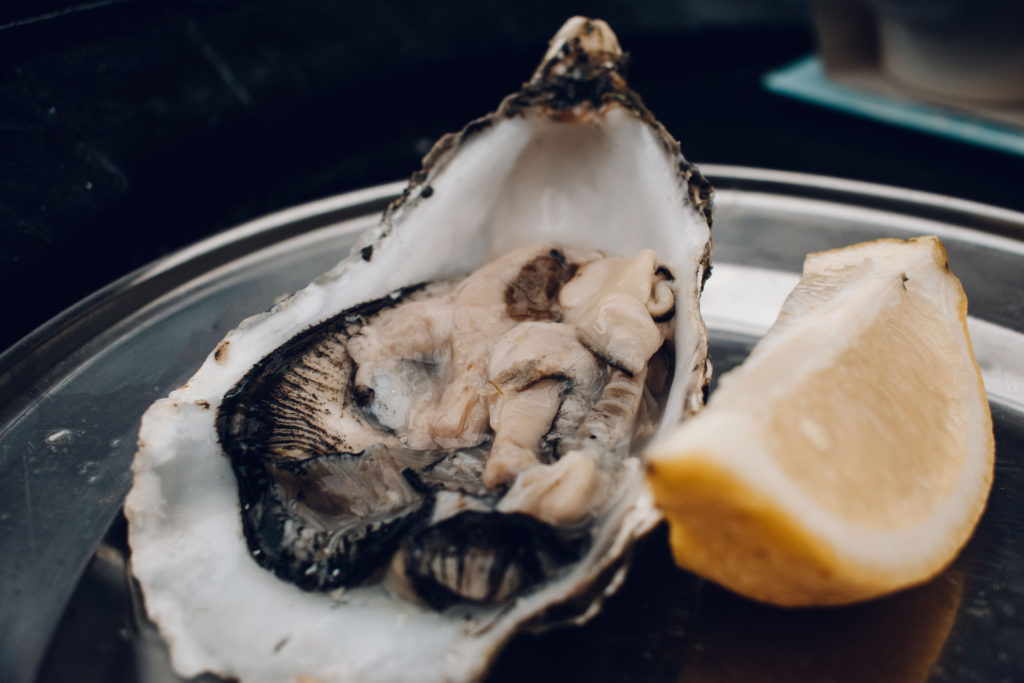
Deli Gasta – friendly café in an old mill serving a lovely selection of cakes and a good lunch menu. The reassuringly overfilled cheese toasties are the perfect antidote to a cold day! Impressively wide range of vegan choices. It’s the first – or last stop – if you’re driving over the bridge to mainland Scotland.
The Three Chimneys – one of Scotland’s most renowned and highly-awarded restaurants. Really, seriously special food. It is not cheap, so one for a special occasion. Reservations (a fair way in advance) are essential. Accommodation is also offered.
Cuillin Brewing Co/Glenbrittle Campsite – quirky little cafe with a small shop. Shop has a nice range of local products to take home a slice of Skye, including some good sustainable outdoor/camping items. Jacket potatoes (with fillings such as hot smoked salmon and BBQ pulled pork, and garlic butter) on offer.
Edinbane Inn – fish and seafood dominate the menu at this cosy local pub. The scallop special was superbly cooked, and our mains of hake and mussels were seriously good. As for the Talisker and honey pannacotta… yummy! Friendly staff, cosy atmosphere. Live music sessions some nights. The Husband declares their own larger lovey and refreshing after a hot day on the hills. He also thought it would be a nice, light larger regardless of the (more likely) pouring rain.
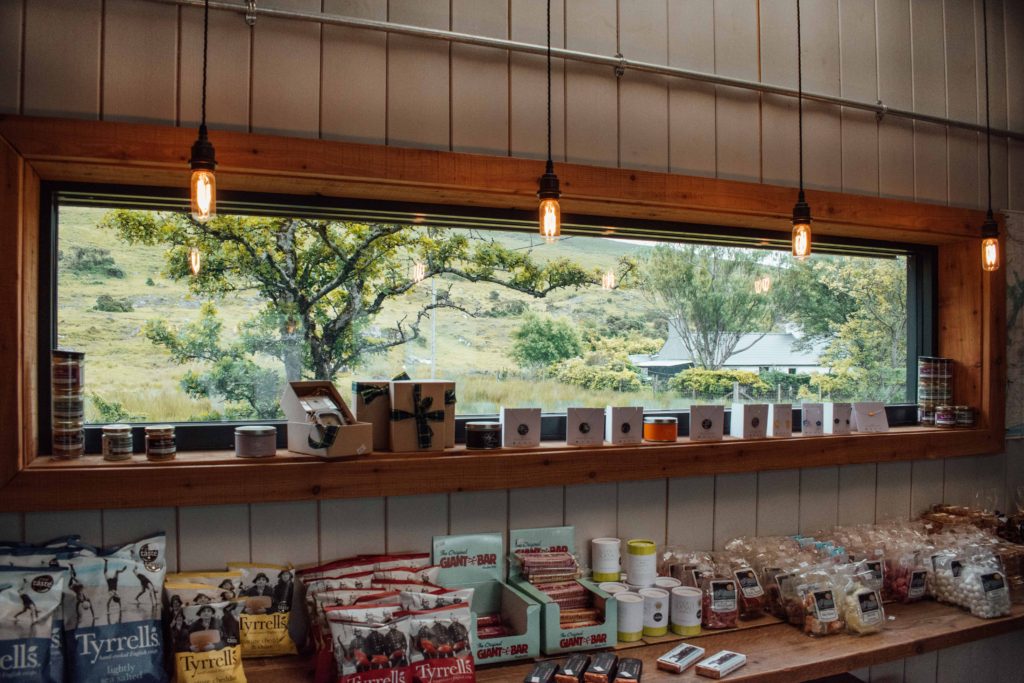
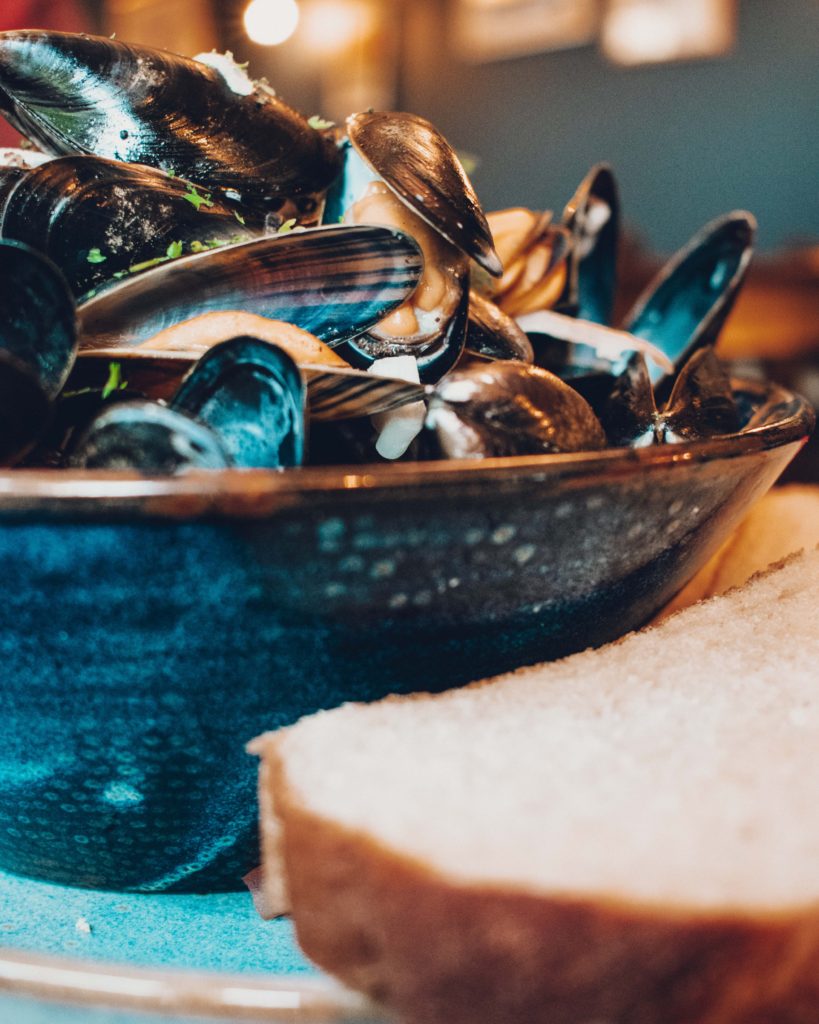
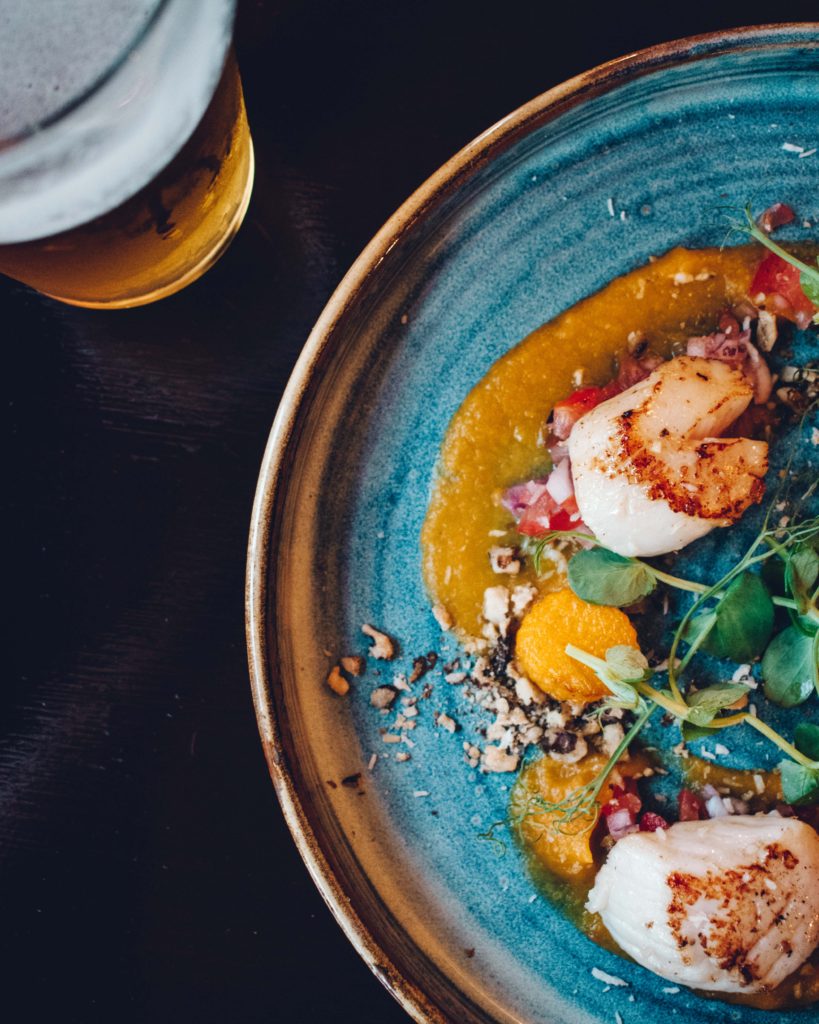
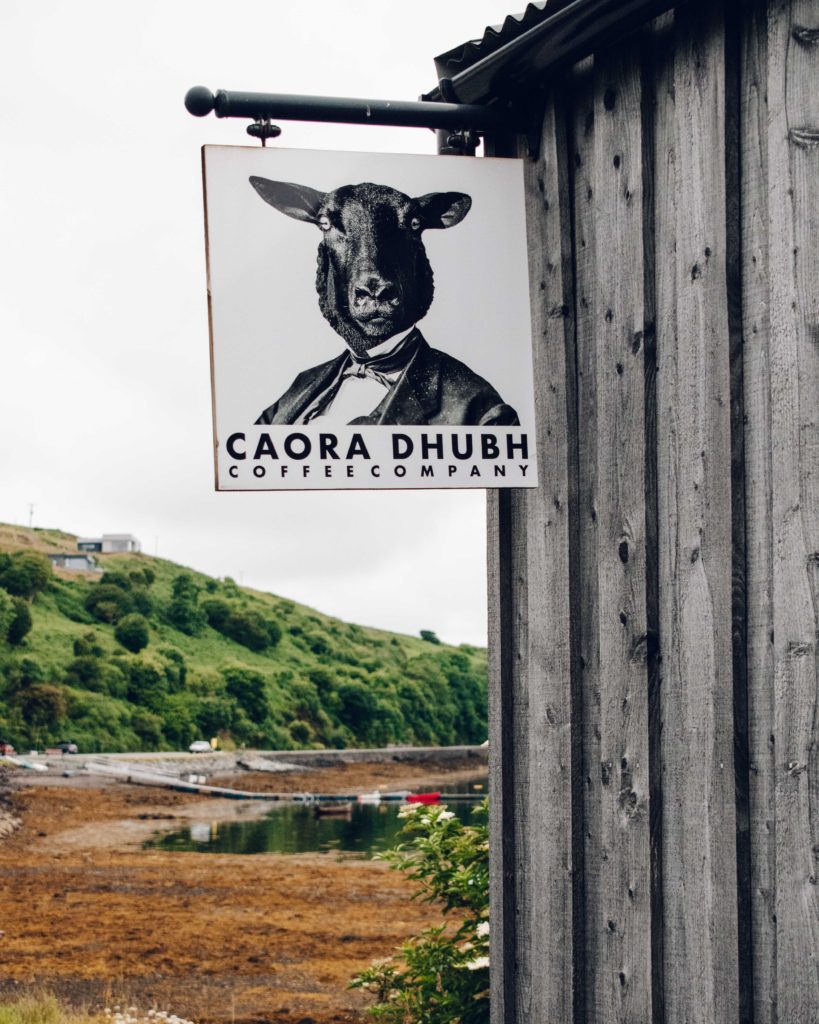
Caora Dubh – very friendly staff, with good tips for exploring Skye. Really fantastic, decadent traybakes. The goey flapjack, with a seam of raspberry jam and a topping of set yoghurt was like something straight from heaven at the top of a wet, misty, cold Corie Lagan! Good coffee, with beans and ground available to buy.
Dulse and Brose – part of the super sleek Bosville Hotel, the food is Scottish bistro. The menu is short but focuses on local highland produce and has a wide range of Scottish cheeses for desert.
Chidakasha – a bit of a gem! Beautifully presented and locally sourced vegetarian and vegan menu, in a cosy, homely atmosphere. It is a tiny wee place, and fairly remote, so book ahead to avoid disappointment.
WHERE TO DRINK
Seamus’ Bar – more than 400 single malts are stocked in this friendly, popular bar. The micro Cuillin Brewery is situated right next door. It is a real climber and hiker focal point, and food is hearty and warming. We actually stayed at the adjacent Sligachan Hotel. We had very high hopes, and it was the most expensive place we stayed on Skye, but sadly ended up being the most disappointing. The staff were friendly but the general atmosphere was chaotic, and service definitely not up to the price point they are pitching at. I booked to give The Climbing Mad Husband a view of the Cuillins from bed, but unfortunately we looked out onto the small parking area! The decor was nicely done, and the bathroom and shower in particular, was excellent. But whilst the bed was comfortable, the rest of the room was filled with such a large sofa it left little space for moving around. If it had been half the price we would have left feeling it was a fun, quirky, family run hotel with lots of history. But sadly we just felt a bit fleeced!
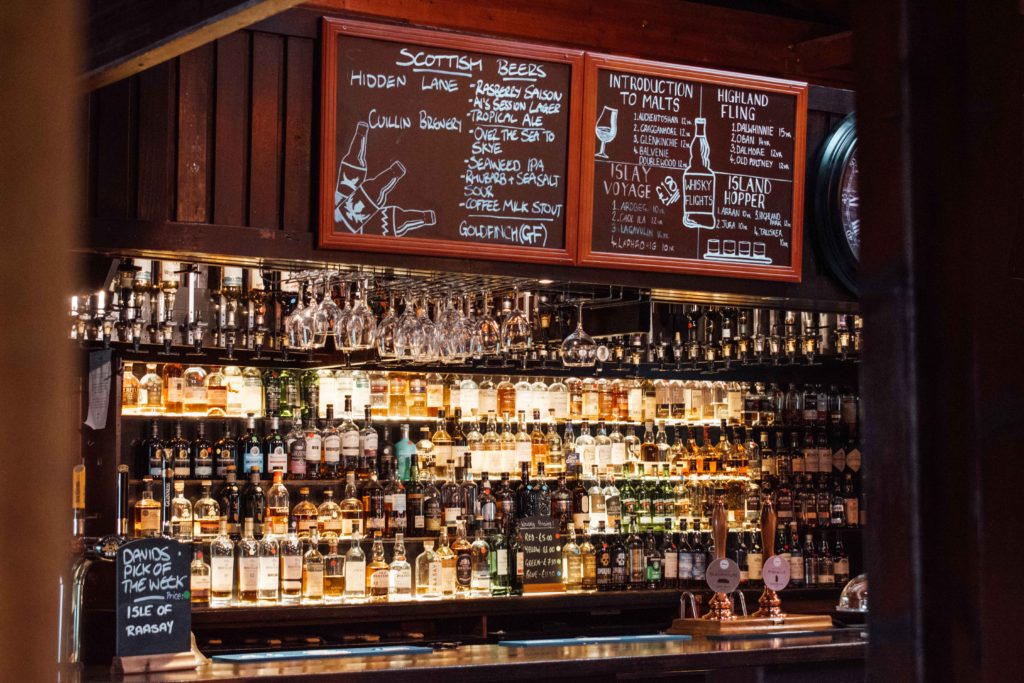
Stein Inn – informal dining at the oldest pub on Skye makes for a lovely spot to sit and watch the sun set on a sunny evening. It is one of Skye’s best bars for whisky lovers, with 130 single malts on offer. Just remember to take your anti-midge spray… or sit inside!
WHERE TO STAY
If you aren’t camping, I strongly recommend booking accommodation as early as possible – at least three months in advance if you are travelling in the summer months, if not more!
Camping! – wild camping is legal in Scotland, provided you follow a set of clear guidelines known as the Outdoor Access Code. A full guide to wild camping is coming soon, but if you plan to sleep out under the stars or want to travel in a campervan, be sure to think carefully about your impact on the surrounding environment and communities when choosing a spot. If an area looks busy, move on to find another spot. As ever, ensure you take all your rubbish with you – and even better, pick up any that you find when you arrive!
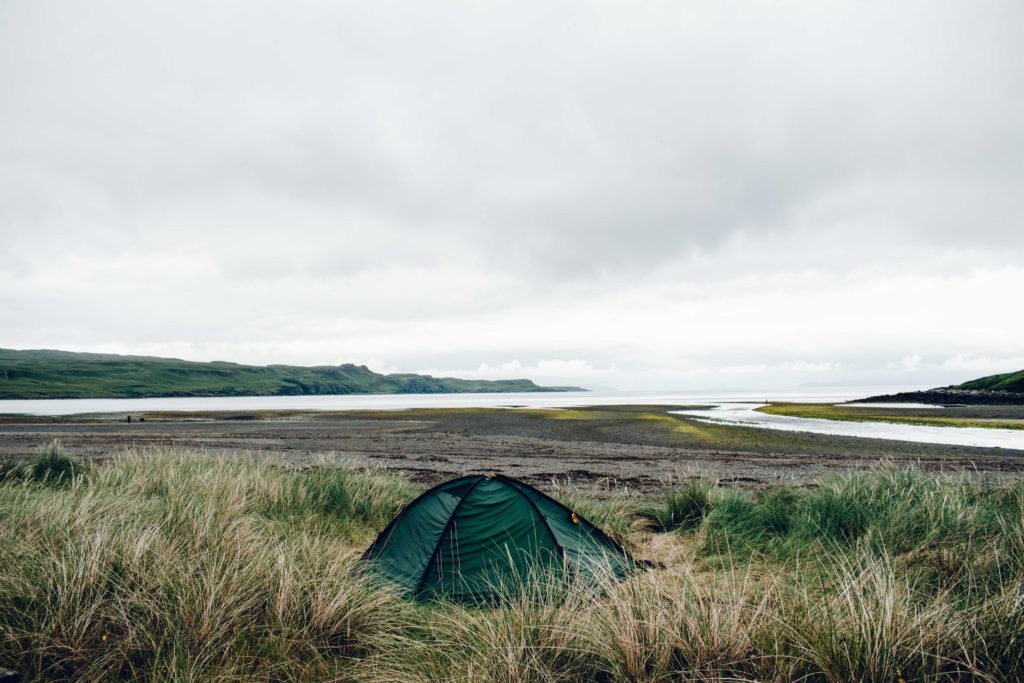
Cullin Hills Hotel – a former hunting lodge set in fifteen acres, with a very well stocked whisky bar. The vibe is warm and traditional.
Marmalade Hotel – lovely, modern design hotel. Spacious rooms, with luxuriously comfy beds, overlook either the gardens or hills beyond. Short walk from the harbour and Portree’s eating and drinking establishments.
The Bosville – cosy boutique hotel with gorgeous Scandi-style minimalist interiors. Lovely touches from local artisans – including beautifully woven textiles and hand thrown ceramics.
The Studio – contemporary, design focused cottage set into the landscape. Stripped back wood interiors, and full length windows make the most of the setting.
The Crofter’s House – seriously gorgeous cottage for two. Original 1830’s croft which has been completely renovated, in a wonderfully quiet rural location.
Harlosh Black H – so sleek it almost hurts! Super minimalist, and super gorgeous. The bedroom views are to die for.
Have a look at my other guides to Scotland and the wider UK if you want to combine your visit with more British travels. Alternatively, if you are keen to find more ideas for hiking, swimming and outdoors trips, have a look at my adventure series.




Leave a Reply